
The Bottom Line
Introduction
NVIDIA has released two out of three of its Turing-based GeForce RTX graphics cards in the last month, with the release of the GeForce RTX 2080 Ti and GeForce RTX 2080, but now it's time for the more mid-range of the RTX series (at least so far) with the release of the GeForce RTX 2070.
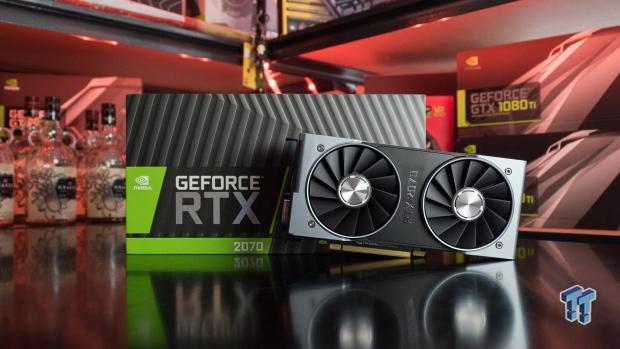
The timing was extremely tight on this one, with my GeForce RTX 2070 Founders Edition only turning up 24 hours ago. I've had less than a few hours with the card but got all of my traditional testing done. There are custom RTX 2070s turning up as I type, so I'll do more of an analysis as I go through the samples. For now, this is a quick and dirty look at the GeForce RTX 2070, a new Turing-based offering that was built for 1440p gaming.
It has been slightly knocked down in terms of CUDA cores and GDDR6 memory from its bigger brothers, with the TU106 being used compared to the TU104 on the RTX 2080 Ti and RTX 2080. The TU106 and thus RTX 2070 feature 2304 CUDA cores, and 8GB of GDDR6 at 14Gbps. The RTX 2080 Ti and RTX 2080 both feature the TU104 GPU with 4352 CUDA cores and 11GB of GDDR6. The GDDR6 memory on the RTX 2070 stays at its high 14Gbps of bandwidth, offering a huge improvement in memory bandwidth over the GeForce GTX 1070.
One of the major changes with the GeForce RTX 2070 is that it doesn't include an NVLink connector, which means no multi-GPU actions with RTX 2070s in SLI/NVLink. If NVIDIA allowed this, you could buy two RTX 2070s for $1000 or so and have some stellar performance that would easily beat the RTX 2080 Ti... at least in games where using multi-GPUs is a good thing.
This is something to keep in mind going into the review, as the GTX 1070/1080/1080 Ti all have SLI support for future upgrade paths while the RTX 2070 does not. I don't think it's that big of a deal, but it could show a trend going forward for NVIDIA: no more SLI on cards under $500.
Pricing & Availability
NVIDIA is pricing its new GeForce RTX 20 series cards at much higher prices than previous-gen launches, but then again the company never launches its 'Ti' variant at launch so these are different times. The new GeForce RTX 2080 Ti Founders Edition launches at $1199, the same price as the Pascal-based TITAN Xp. But the RTX 2080 Ti overall, starts at $999 while NVIDIA's higher-end Founders Edition knocks the price up to $1199.
- GeForce RTX 2080 Ti - $999-$1199
- GeForce RTX 2080 - $699-$799
- GeForce RTX 2070 - $499-$599
The new GeForce RTX 2070 starts from $499 for a stock card from an AIB, while custom cards will be somewhere above $500, and NVIDIA's own GeForce RTX 2070 Founders Edition will cost $599.
Specs: Turing GPUs
Detailed Specs
NVIDIA's new GeForce RTX 2080 Ti is the biggest and best GeForce ever made, and while that might be true with most launches we never see the launch of the Ti version of the card until many months after. NVIDIA launched the GeForce GTX 1070 and GTX 1080 in May 2017, while the GeForce GTX 1080 Ti was unveiled in March 2018. But the problem was the GeForce GTX 980 Ti was still a powerhouse card, just without a few of the features from the new Pascal architecture.
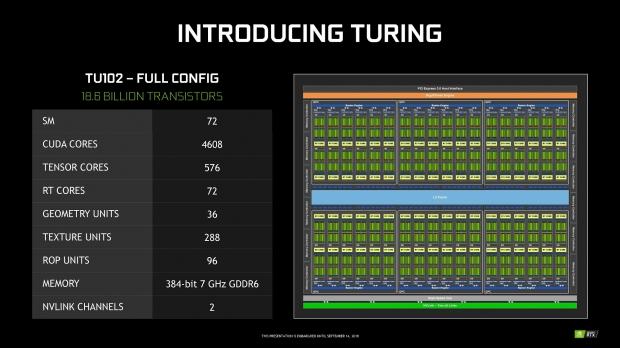
This time around NVIDIA is launching offensively, almost as if AMD actually hit success with Radeon RX Vega, out and throwing their arms down like Henry Cavill in Mission Impossible: Fallout. The new GeForce RTX 2080 Ti is an absolutely jam packed technological orgy, with the next-gen Turing GPU architecture, on the new 12nm process, and is joined by the first use of GDDR6 memory technology.
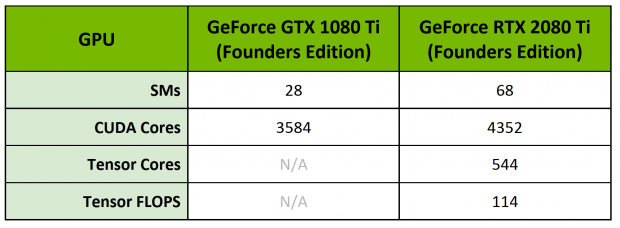
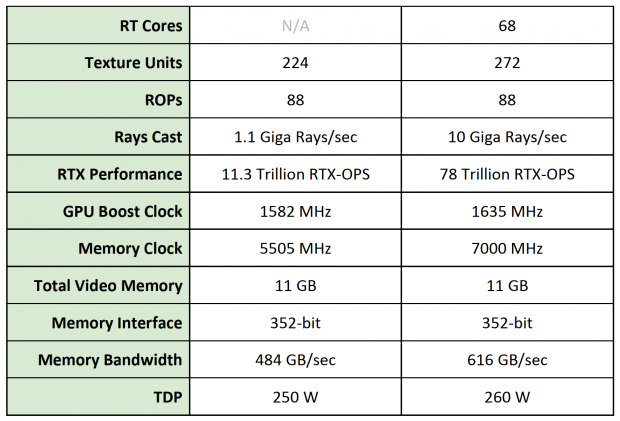
The GeForce RTX 2080 Ti has a huge 4352 CUDA cores, 68 RT Cores, and 544 Tensor Cores - some of these new cores that come with the Turing GPU architecture won't be used much with this climate of games but expect that to change very quickly.
TU102/104 vs GP102
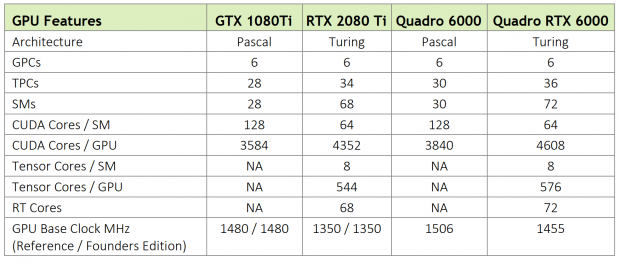
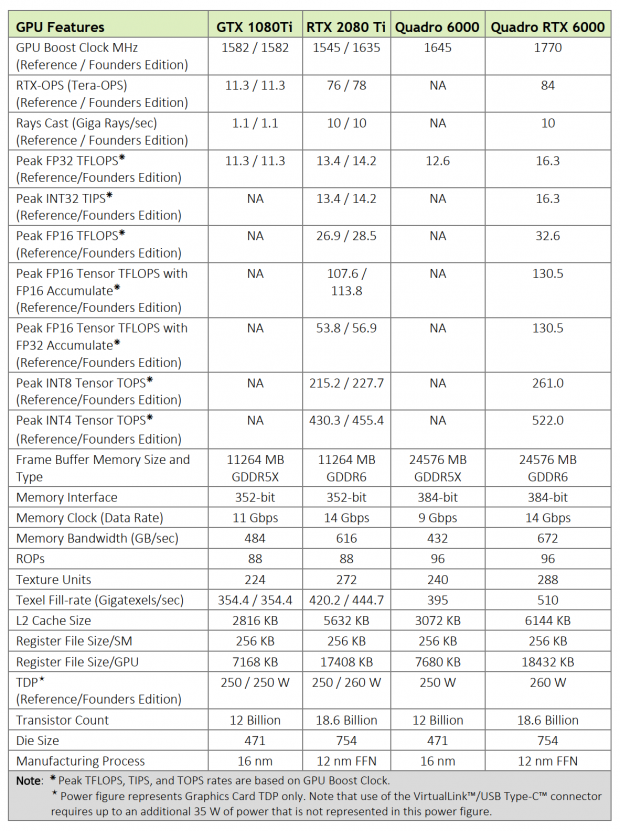
TU106 vs GP104
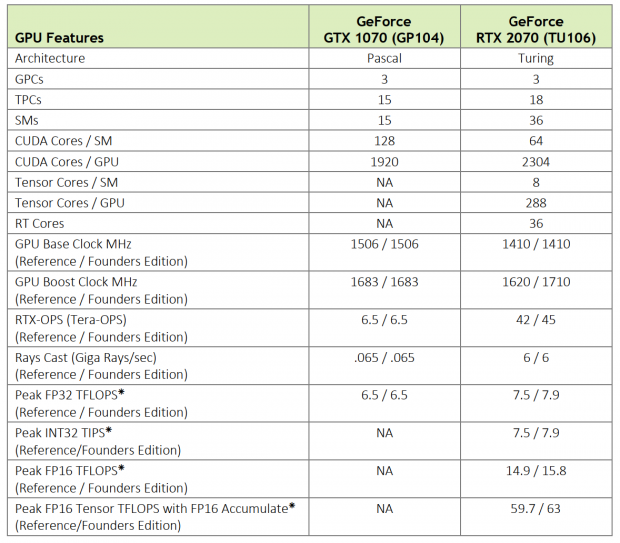
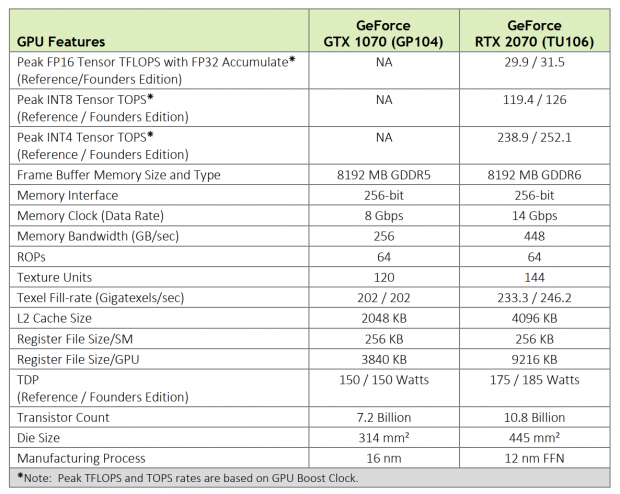
TU102
NVIDIA's new TU102 GPU is an absolute powerhouse of technology, with a huge 18.6 billion transistors on 12nm. TU102 packs 4608 CUDA cores, 72 RT Cores, 576 Tensor Cores, 288 texture units and 12 x 32-bit GDDR6 memory controllers that makes up a 384-bit memory bus.
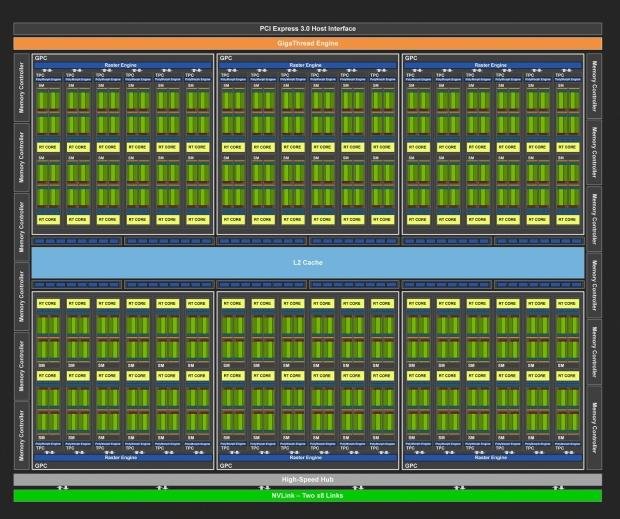
Each of the 72 SMs on TU102 has 64 CUDA cores, 8 x Tensor Cores, a 256KB register file, 4 texture units, and 96KB of L1/shared memory that can be used in either compute or graphics workloads. Each memory controller has 8 ROP units and 512KB of L2 cache, with the full TU102 GPU packing 96 ROP units, and 6144KB of L2 cache.
TU104
NVIDIA's new TU102 GPU is joined by the cut down TU104 that has all of the new Turing features, as well as GDDR6 memory technology and NVLink. The full TU104 chip features 6 x GPCs, 48 SMs, and 8 x 32-bit memory controllers (for a total of a 256-bit memory bus). TU104 sees each GPC cluster featuring a raster unit and 4 x TCPs, with each TCP containing a PolyMorph Engine and 2 x SMs.
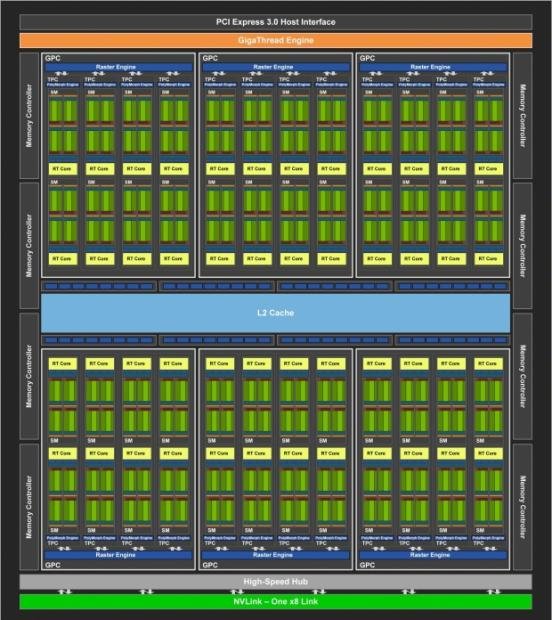
Inside of each SM is the exciting new RT Core, with each SM featuring 64 CUDA cores, 256KB register file, 96KB L1 data cache/shared memory cache, and four texture units. TU104 features 13.6 billion transistors, 3072 CUDA cores, 368 Tensor Cores, and 48 RT Cores. TU104 is the card that powers both the GeForce RTX 2080 and Quadro RTX 5000 cards.
TU106
TU106 will power the upcoming GeForce RTX 2070, and is a direct competitor against the GTX 1070 and will ship in October 2018. TU106 features 10.8 billion transistors, 2304 CUDA cores, 288 Tensor Cores, and 36 RT Cores. The transistor count on TU106 is much greater than its Pascal counterpart in the GP104, with the new TU106 GPU featuring 10.8 billion transistors versus the 7.2 billion inside of GP104.
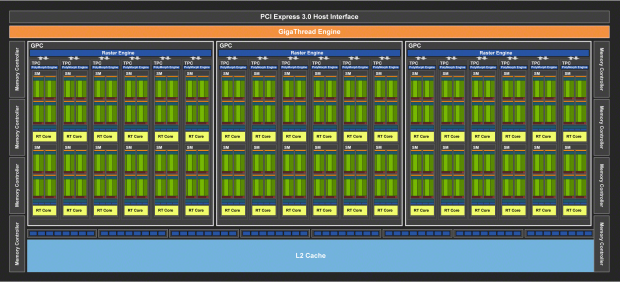
TU106 has 3 x GPCs, 36 SMs, and 8 x 32-bit memory controllers (for a 256-bit memory bus, the same as the RTX 2080). NVIDIA's new TU106G GPU sees each GPC with a raster unit and 6 x TPCs, with each TPC packing a PolyMorph Engine and 2 x SMs. Each of the SMs inside of TU106 will, like TU102 and TU104, feature the new RT Core for ray tracing. Each SM packs 64 CUDA cores, 256KB register file, 96KB L1 data cache/shared memory cache, and 4 x texture units.
Specs: GDDR6 Memory
Next-Gen Memory: GDDR6
NVIDIA's new GeForce RTX 20 series graphics cards are the first ever to make use of GDDR6 memory technology, of which NVIDIA has 11GB on the GeForce RTX 2080 Ti that kicks off at 14Gbps of memory bandwidth. The new GeForce RTX 2070 has 8GB of GDDR6 at the same 14Gbps of bandwidth.
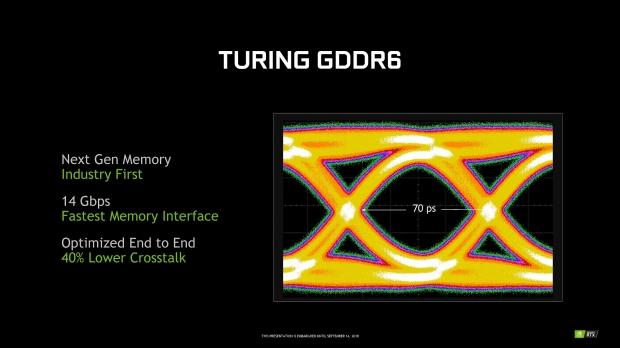
This type of memory bandwidth is incredibly important as the resolution of your games scale, with 4K really needing the increased GPU horsepower and especially the much faster memory. 8GB of next-gen GDDR6 at 14Gbps is a pretty large jump over the GeForce GTX 1070 which had the same 8GB framebuffer but used GDDR5 with memory clocks of only 8Gbps in comparison.
The 8GB of GDDR6 on the new GeForce RTX 2070 is on the same 256-bit memory bus as its GTX 1070 predecessor, but the new GDDR6 has radically more bandwidth at its disposal. We're talking about 448GB/sec of memory bandwidth on the RTX 2070 over the 256GB/sec on the GTX 1070.
NVIDIA explains GDDR6 as the "next big advance in high-bandwidth GDDR DRAM memory design", something that is enhanced "with many high-speed SerDes and RF techniques, GDDR6 memory interface circuits in Turing GPUs have been completely redesigned for speed, power efficiency, and noise reduction. This new interface design comes with many new circuit and signal training improvements that minimize noise and variations due to process, temperature, and supply voltage. Extensive clock gating was used to minimize power consumption during periods of lower utilization, resulting in significant overall power efficiency improvement. Turing's GDDR6 memory subsystem delivers 14 Gbps signaling rates and 20% power efficiency improvement over GDDR5X memory used in Pascal GPUs".
Turing's package and board designs were "carefully crafted" to handle the higher speed requirements, something that is helped along with a huge 40% reduction in signal crosstalk, which NVIDIA says is "one of the most severe impairments in large memory systems". NVIDIA says that "every aspect of the memory subsystem was carefully crafted to meet the demanding standards that are required for such high frequency operation. Every signal in the design was carefully optimized to provide the cleanest memory interface signaling as possible".
New Look, New Cooler, New GeForce
NVIDIA has put in an incredible amount of effort into the new RTX 2080 and RTX 2080 Ti Founders Edition graphics cards. It looks great, and is the best reference GeForce graphics card ever made in my opinion. I really love the look of it over most of the custom cards, but I'm expecting some far better higher-end custom cards from the likes of MSI, ASUS, and ZOTAC in the near future.
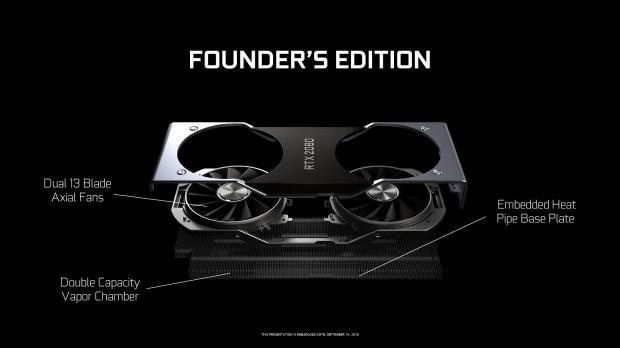
As it stands, the new Founders Edition has been fully enveloped by the new-look shroud, providing an overall more stylish design and feel. NVIDIA has even provided a removable cover on the NVLink connector, so that the design aesthetics aren't interrupted. It really is a stunning card. NVIDIA's new GeForce RTX Founders Edition graphics cards feature the first-ever full-length vapor chamber combined with dual axial fans, a huge upgrade over the single-fan cooling solutions of every reference and FE-based card until now.
Inside there is a lot of stuff going on, with the full-length vapor chamber covering the entire PCB of the RTX 20 FE cards. This means heat has much more space to escape the important components like the Turing GPU and GDDR6 memory, with our RTX 2080 Ti Founders Edition hitting 76C maximum in heavy loads, compared to 83C on the GTX 1080 Ti and TITAN Xp graphics cards.
The new dual-axial fans were designed to pull heat away from the massive heat sink, and blow it out the back and sides of the card. There's a metal baseplate on the RTX Founders Edition cards, resting on top of the low-profile board components keeping the power circuitry and GDDR6 memory modules as cool as they can.
iMON DrMOS Power Supply
NVIDIA has beefed up the power subsystem on the RTX 2080 Ti FE compared to the GTX 1080 Ti FE, with a new 13-phase iMON DrMOS power supply compared to the 7-phast dual-FET power supply used on the GTX 1080 Ti FE. There's a new dynamic power management system that NVIDIA has capable of sub-millisecond current monitoring and control. This means the RTX Founders Edition cards have more control over the flow of power into the GPU, and giving more headroom for overclocking.
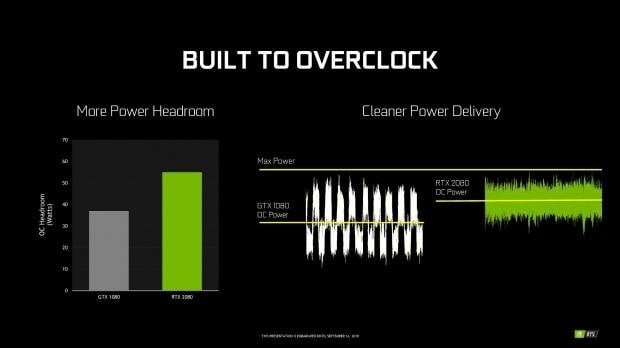
NVIDIA says that the new iMON power supply is "extremely efficient" and can supply the GPU with more power cleanly, with less power wasted as heat. Higher GPU overclocks are the result of this new iMON power supply, where it can dynamically switch to less power phases when the power subsystem isn't fully loaded. This means the power supply can run at peak efficiency when the GPU loads are idle, normal gaming with stock clocks, and then maximum load for intense gaming or GPU/GDDR6 being overclocked.
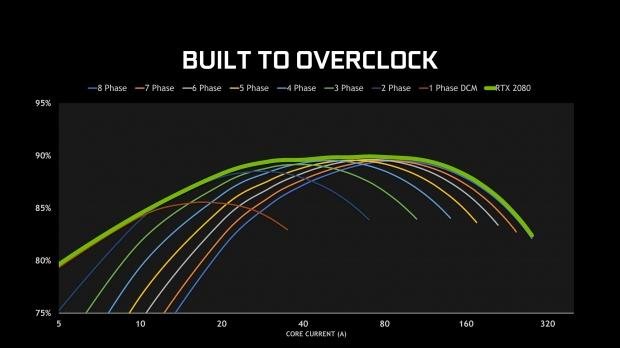
See what I mean, the GeForce RTX 2080 and RTX 2080 Ti are built for overclocking.
3-Phase Power System Just For GDDR6 @ 14Gbps
NVIDIA's use of the super-fast GDDR6 memory at 14Gbps sees a dedicated 3-phase power system dedicated to the GDDR6 memory.
Detailed Look
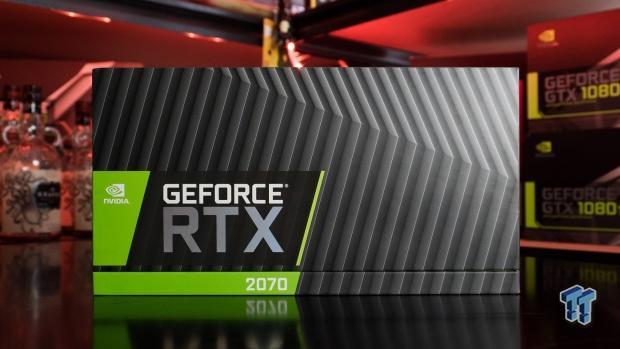
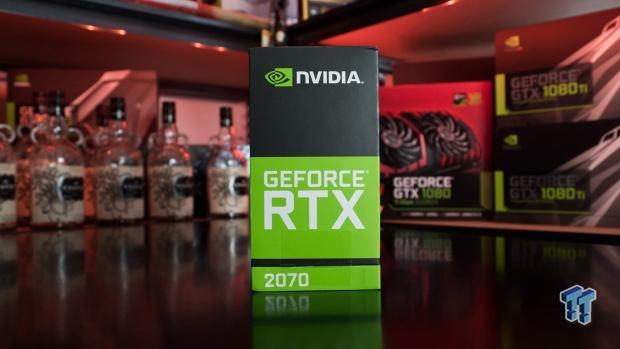

NVIDIA continues its slick new retail packaging with the GeForce RTX 2070 Founders Edition, but it's a smaller box as the RTX 2070 itself is physically smaller than the RTX 2080 and RTX 2080 Ti.
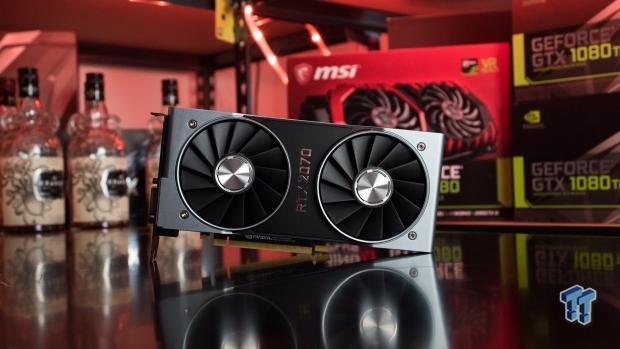
As you can see, the RTX 2070 FE looks just like the other RTX Founders Edition cards with its dual-fan cooler... except this card is shorter than the other cards, and has a different PCIe power connector placement.
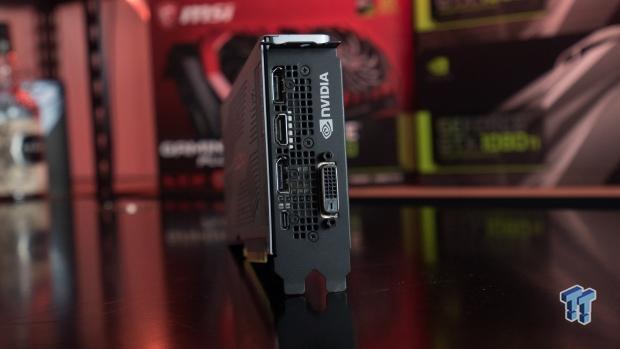
The display connectivity is changed on the GeForce RTX 2070 Founders Edition, with the third DIsplayPort connector replaced for a DVI port. The new VirtualLink connector is there, with the USB Type-C port ready for next-gen VR headsets.
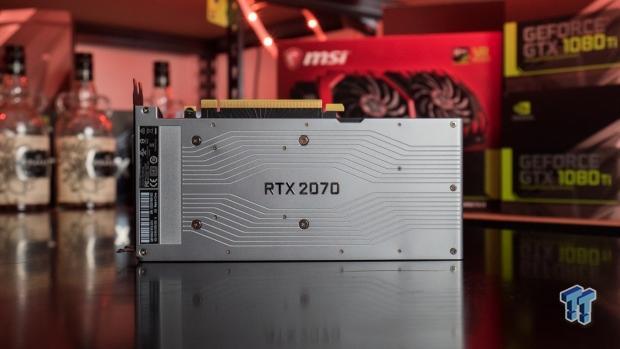
The same silver backplate is used on the RTX 2070 Founders Edition.
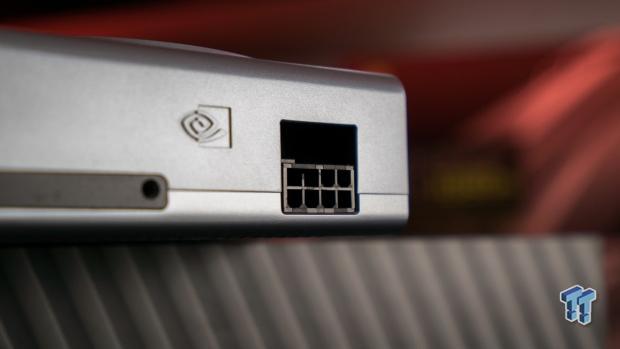
NVIDIA has placed the single 8-pin PCIe power connector on the end of the card, and not on top of the card like every other GeForce card I can remember.
Turing: NVLink Multi-GPU Tech
No NVLink Love On RTX 2070
There is no NVLink connector on the GeForce RTX 2070, but that doesn't mean you shouldn't know about it. Here's what to expect from NVLink with the RTX 2080 and RTX 2080 Ti graphics cards.
NVLink = Huge Multi-GPU Upgrade
Before the previous-gen Pascal architecture, NVIDIA GPUs used a single Multiple Input/Output (MIO) interface as the SLI Bridge technology, which allowed the second/third/fourth GPU to transfer its final rendered frame output to the primary GPU that was physically connected to the bridge.
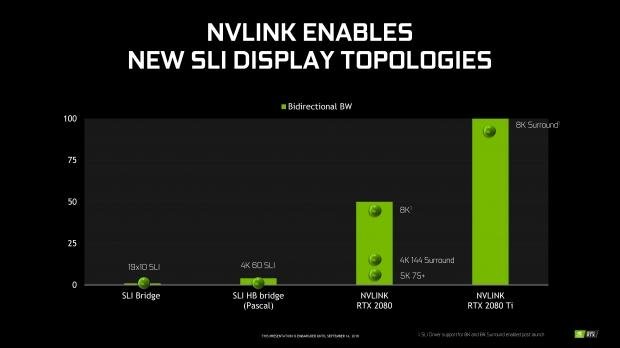
Pascal changed this with a faster dual-MIO interface that arrived as HB-SLI, increasing the bandwidth between the GPUs. This paved the way for higher resolution output, and multiple high-res monitors to be used in NVIDIA Surround. NVLink takes all of this to the next level.NVIDIA has deployed its new multi-GPU technology NVLink into the new GeForce RTX 20 series, but NVLink is not something new for the company as it has used the high-speed interconnect on its Quadro RTX series cards and was made specifically for the Volta GV100 GPU.
TU102 features two NVLink 8x links that can feed out 25GB/sec of bidirectional bandwidth, while total aggregate bidirectional bandwidth hits 100GB/sec.
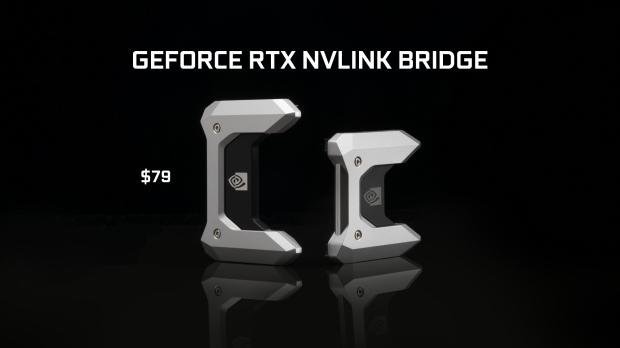
NVIDIA's new Turing-based TU102 and TU104 GPUs now use NVLink for all SLI GPU-to-GPU data transfers, with the higher-end TU102 featuring two NVLink x8 links while TU104 has a single NVLink x8 link. Each individual link provides up to 50GB/sec of bidirectional bandwidth (25GB/sec per way) while the two links in TU102 push 100GB/sec in total (50GB/sec per way).
Turing GPUs only support 2-way SLI over NVLink, but 3-way and 4-way SLI configurations "are not supported".
Turing: RT Cores & Tensor Cores
Tensor Cores
NVIDIA's new Turing GPU architecture features some special herbs and spices with Tensor Cores being one of them. Tensor Cores are specialized execution units that have been designed specifically to perform tensor/matrix operations that are the core compute function used in Deep Learning.
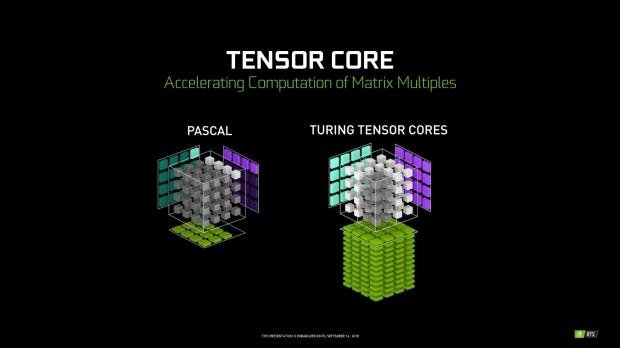
NVIDIA had already struck Tensor Core gold with the Volta GPU architecture, but the new Turing Tensor Cores "provide tremendous speed-ups for matrix computations at the heart of deep learning neural network training and inferencing operations".
Turing Tensor Cores offer deep learning-based AI tricks for GeForce RTX series graphics cards and Quadro workstation cards, with a little something called DLSS or Deep Learning Super Sampling. DLSS is powered by Tensor Cores and uses NVIDIA's deep neural network to "extract multidimensional features of the rendered scene and intelligently combine details from multiple frames to construct a high-quality final image. DLSS uses fewer input samples than traditional techniques such as TAA, while avoiding the algorithmic difficulties such techniques face with transparency and other complex scene elements".
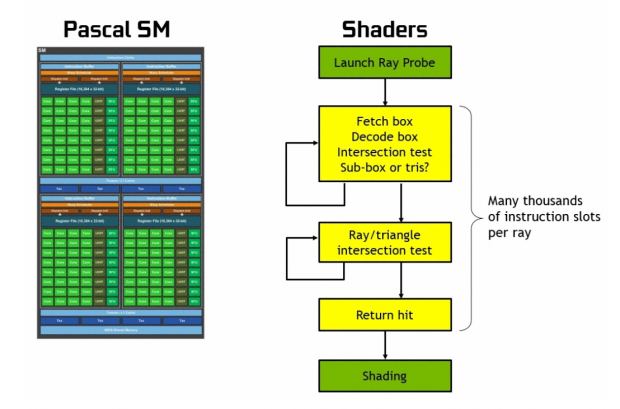
Turing is a much more powerful GPU for ray tracing thanks to its RT Cores, as the GPU architecture was developed from the ground up for ray tracing in mind. You can see the software emulation for BVH (Bounding Volume Hierarchy).
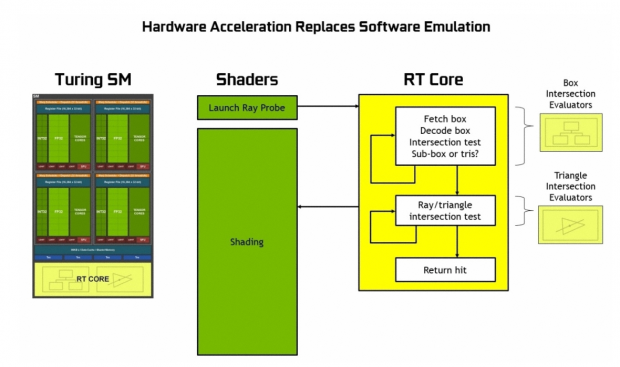
As you can see, the RT Cores hardware accelerate what the Pascal GPU architecture does in software emulation.
Sounds like magic, doesn't it?!
RT Cores
Turing features some fresh new RT Cores with the flagship GeForce RTX 2080 Ti packing 68 RT cores for the highest performance in real-time ray tracing games powered by RTX and other compute tasks.
The new RT Cores in the Turing GPU are untapped right now with only a few games able to take advantage of them, but as time goes real-time ray tracing in games will expand into countless titles. As of now, we have a fair few games with some of them being the biggest games of 2018 including Battlefield V, Shadow of the Tomb Raider, and Control (which arrives in 2019).
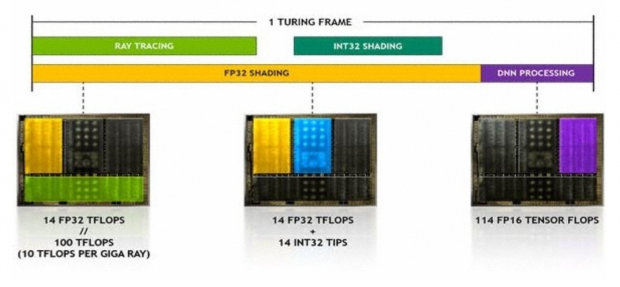
Turing hardware enables real-time ray tracing for lighting and AI in games and other applications, where NVIDIA has created a new rendering model called Hybrid Rendering. Hybrid Rendering uses a combination of traditional rendering, ray traced rendering, and AI that makes images really pop, all in real-time ray tracing. Most of this comes from the power of the Turing GPU, with the flagship GeForce RTX 2080 Ti the perfect card for real-time ray tracing.
The Current List Of Ray Tracing Games
- Assetto Corsa Competizione
- Atomic Heart
- Battlefield V
- Control
- Enlisted
- MechWarrior 5: Mercenaries
- Metro Exodus
- Shadow of the Tomb Raider
- Justice
- JX3
- Project DH
DLSS: Deep Learning Magic & NGX
Deep Learning Super Sampling
DLSS is some true new magic that NVIDIA has unleashed with the Turing GPU architecture, with Deep Learning Super Sampling being one of the most interesting parts of NGX, or Neural Graphics Acceleration. NGX is a new deep learning-based technology stack that is found inside of NVIDIA's new RTX technology.
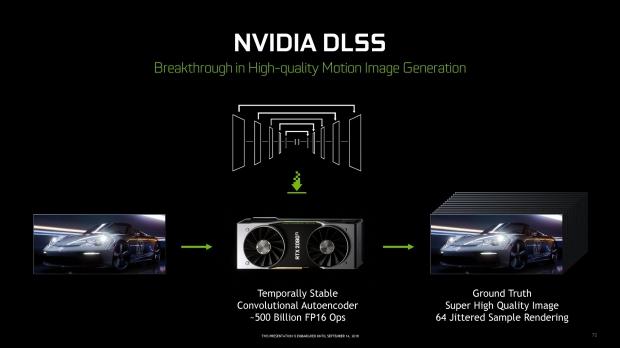
NGX uses deep neural networks (or DNNs) as well as a set of Neural Services that will do AI-based functions that not only improve the graphics of supported games, but it also increases the performance. NGX uses Turing Tensor Cores for deep learning-based operations that end up with better-looking games and higher-performing tasks to users.
In most new games, rendered frames aren't displayed directly, they are pushed through post processing image enhancement that combines input from multiple rendered frames, where visual artifacts are hopefully removed, and aliasing hopefully stays in detail. Temporal Anti-Aliasing (TAA) is a shader-based algorithm that combines two frames using motion vectors to work out where to sample the previous frame, which is one of the most-used image enhancement tools used today. NVIDIA notes however, that the image enhancement process is very hard to get right.
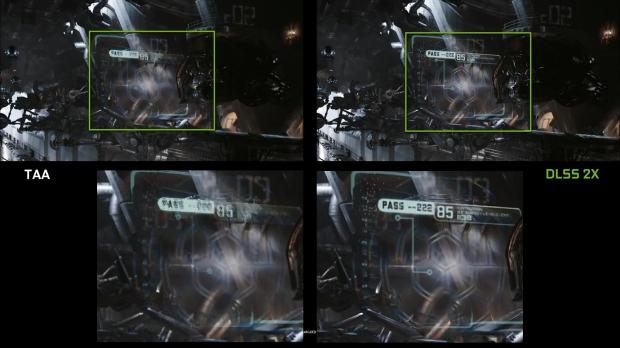
This is where NVIDIA researchers thought that using AI to improve this task would come into play, with the company using its DNN (deep neural network) to solve this issue, which is where Deep Learning Super-Sampling (DLSS) was born. DLSS produces a much higher quality output image compared to TAA, with increased performance in some games that'll blow your socks off.
RTX 2080 Ti Is 100% Faster Than GTX 1080 Ti Thanks To DLSS
TAA will render its final target resolution and then combine frames, subtracting detail...compared to DLSS that renders much faster at a lower input sample count, then infers a result that at the target resolution, looks similar to TAA but does half the shading work to get there. In some tests, like the UE4 Infiltrator demo, there's a 100% performance improvement using the RTX 2080 Ti over the GTX 1080 Ti.
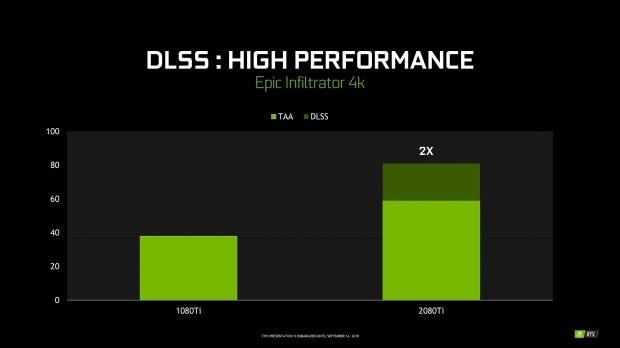
DLSS Feeds NVIDIA's Super Computer
One of the best parts of DLSS is that the results are great for the training process of the DNN, as it gets to stretch its legs on how to best product the desired output image based on large numbers of "super-high-quality" examples. NVIDIA trains its deep neural network by collecting thousands of what it calls "ground truth" reference images that are rendered with the "gold standard method for perfect image quality"... 64x super-sampling (64xSS).
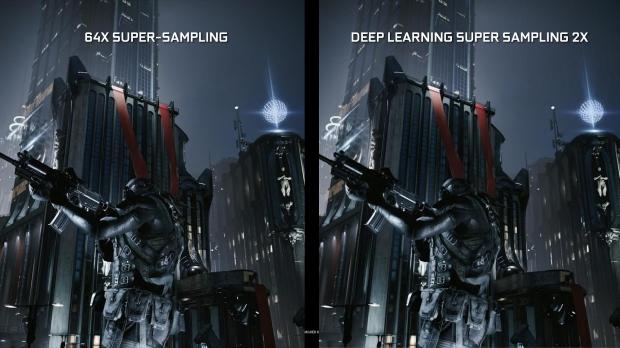
64x super-sampling doesn't shade each pixel a single time, it shades at 64 different offsets within the pixel itself, combines the outputs, and products an image that is with "ideal detail and anti-aliasing quality". NVIDIA also captures matching raw input images rendered normally, where they begin training the DLSS network to match the output frames of 64xSS.
By going through each input, NVIDIA tells DLSS to produce an output and to then measure the distance between its output and the 64xSS image sample, where it "adjusts the weights in the network based on the differences, through a process called back propagation". DLSS will learn after many attempts and tests how to produce results that closely match 64xSS, while also learning how to avoid problems like blurring, dis-occlusion, and transparency that plagues TAA.
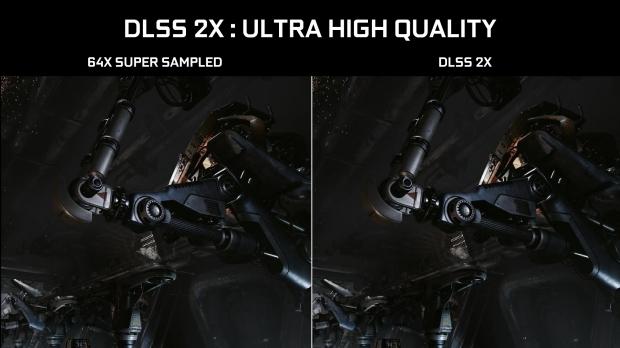
This is all under the standard DLSS mode but NVIDIA also has DLSS 2X which sees DLSS input being rendered at the final target resolution and then combined by an even bigger DLSS network that is capable of producing an output image that is close to the look of the 64x super-sampled rendering. NVIDIA notes that this would provide a result that would be "impossible to achieve in real-time by any traditional means".
DLSS Support - More On The Way
There are 15 games with DLSS support, and lots more of them on the way.
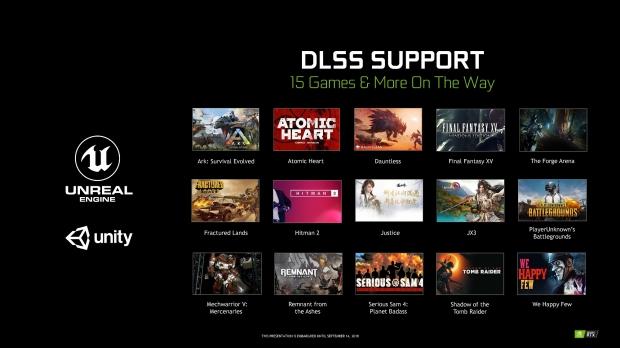
NGX Software Architecture
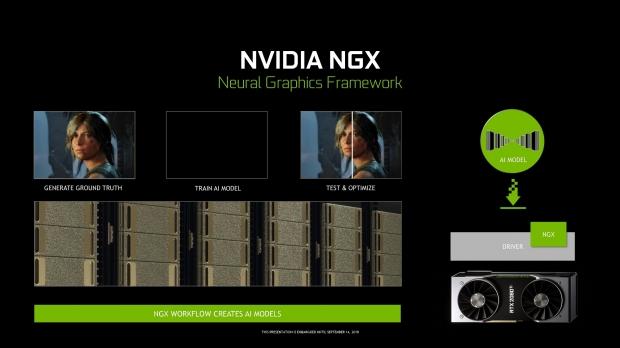
Another new thing inside of Turing is NGX or Neural Graphics Framework, which is where all of the AI models are created, stuffed into the driver and into your shiny new GeForce RTX graphics card.
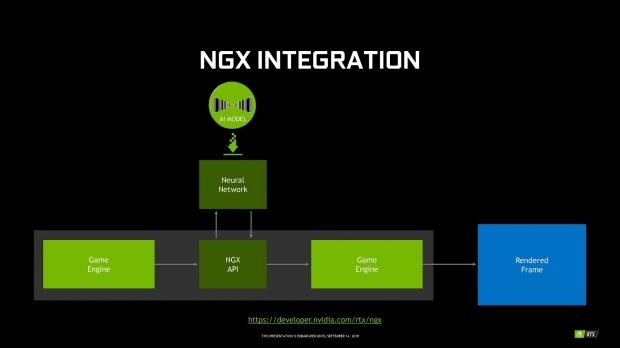
NGX integration is easy: the AI model trains it, passes it through the neural network into the NGX API alongside the game engine, and into the rendered frame you see on your monitor.
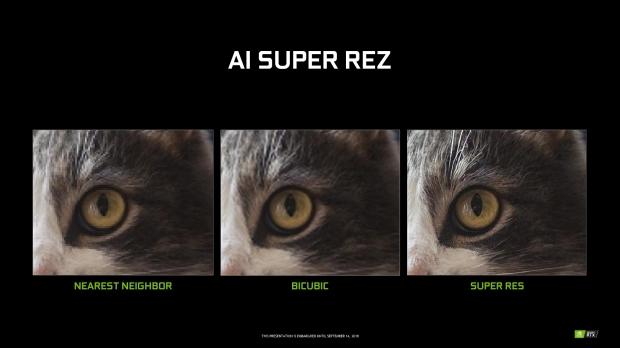
We can expect some cool tricks from this, such as AI Super Rez that takes the image into the deep neural network and then blasts back a Super Res version of it. Imagine the possibilities with images, videos, and most of all gaming - powered by AI and DNNs.
AI To Power The Future Of Gaming
AI Will Eventually Be Better Than You At Games
When I was at the GeForce Gaming Celebration I talked to some NVIDIA staff about what the future of gaming would be like powered by the new AI abilities mixed with the Tensor Cores inside of Turing. The back-and-forth chat was beyond illuminating, really inspiring me that the future of gaming on PC will take things to the next level.
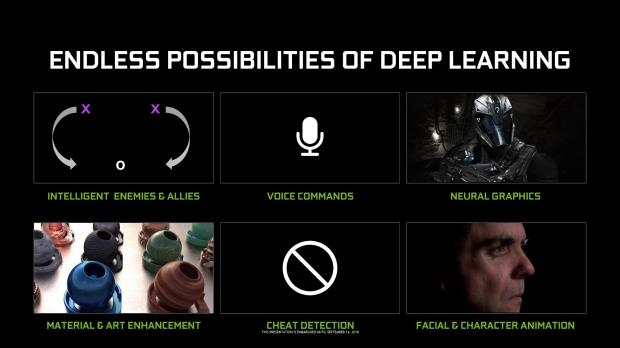
I was told about a game in the future would create scenarios where a player would advance on let's say, a military base with a few AI-based characters standing guard at the entrance. There's a button one of them would press in an emergency to alert the entire base of your presence, so you have multiple options to enter the base.
In this instance you are approaching the guards and want to take one down, so you crawl up the mountain slowly so that they don't see you. Remember, they don't have traditional vision and AI, but we're talking AI hardware that gives them almost individual personalities and human-like reactions to situations.
You pull out your sniper rifle and take out the guard on the left, an action that snaps the other soldiers mind and he panics. His friend has just been killed in front of him, so he looks at the body realistically (leaning over and checking on him) and as he turns to you, through the zoomed-in scope on your sniper rifle, you see his reaction.
The look of anger. The look of someone who has nothing going through their mind but ending your life. The AI would be powering a character in the game that would think like you. Does he begin cover firing and getting out of the way of your next shot, or does he shoot out the lights above him that allow you to see him?
AI will be smart enough to adapt to the situation at hand, so in this instance he shoots the light out above him descending your vision into darkness. The base has been alerted, the lights are out, and you don't have night vision. Your journey into the base just got 10x harder as you have AI that is beyond the levels we play with now, with human-like abilities and thought patterns.
The future of AI won't hide behind a wall waiting for you or running in circles, they're going to hunt you down in packs. You will be versing AI that is being driven by RT Cores and the Turing GPU architecture on NVIDIA's new GeForce RTX 2080/2080 Ti (and beyond) that is just as smart, and sometimes even better than good human gamers.
The fun with AI doesn't stop there, as we could see a total resurgence in all genres of games from the help of RT Cores, Deep Learning, and AI. Another genre would be horror. Imagine a next-gen reboot of the likes of Resident Evil or F.E.A.R. - because that's something I could get behind.
A new Left 4 Dead with the AI Director (that is already built in the game and tuning the game dynamically based on players' behavior and advancement in the game) being real AI driven by RT Cores. An AI that is dynamically adjusting the game with individual zombies and larger enemies (Smokers, Witches, etc) with much more powerful AI driving them at human-like levels.
Zombies could hunt you in packs, making them scarier and more dangerous than ever before. They could hunt you like animals using senses that they don't have now... imagine that RT Cores and AI could have them smelling you... yes, smelling you. This would make you have to think much more in the game about what exactly is attacking you, and how best to hide or run from it.

If you can't kill the zombie or animal tracking you, you might have to cover up your footprints through the dirt, sand, or mud. You will be forced to find water to jump into to mask your scent, or deal with a horde of AI-driven zombies that are smashing the house you're in to pieces at all different doors and windows confusing you to where they are and how you'll escape.
NVIDIA has provided the technology for the future of games, and now it's up to developers to tap the power of RT Cores in the Turing architecture. The only thing that I fear is that most games are multi-platform, so this would mean one of two things. First, we have normal games with additional RTX-specific AI features sprinkled on top of existing games and their pre-built AI.
Secondly, developers really tap into the RT Cores and AI power of Turing and make it part of the DNA of the game: truly next-gen AI that is similar to the stories that I heard in Germany at the GeForce Gaming Celebration event, or beyond. I want to sh*t my pants in a horror game that adapts to me... I want to have AI in shooters that is as good as a human opponent, I want to get smashed in RTS games against true AI.
The more exciting thing is that we're only scratching the possibilities of what could be the future of gaming powered by AI... it truly is limitless with NVIDIA's new Turing GPU architecture.
WTF IS RTX-OPS
NVIDIA Defines RTX-OPS
NVIDIA is so far ahead of AMD right now that it's in totally new territory with the Turing GPU architecture, so it has had to use its own "RTX-OPS" when trying to define performance of Tensor-related compute tasks. We won't be using RTX-OPS in our day-to-day benchmarks or RTX 20 series reviews, but it definitely deserves its own page to explain WTF is RTX-OPS.

The way NVIDIA works out RTX-OPS, the company explains that the "peak operations of each type based is derated on how often it's used". NVIDIA cites:
- Tensor operations are used 20% of the time
- CUDA cores are used 80% of the time
- RT cores are used 40% of the time (half of 80%)
- INT32 pipes are used 28% of the time (35% of 80%)
For example, RTX-OPS = TENSOR * 20% + FP32 * 80% + RTOPS * 40% + INT32 * 28%.
GPU Boost 4.0 & NVIDIA Scanner
NVIDIA has made the most overclockable GeForce graphics card yet with the new RTX 20 series, with the company openly embracing overclocking as a whole and making it easier than ever to overclock. We have the refreshed GPU Boost 4.0 technology and NVIDIA Scanner, software that will overclock your GPU for you... yeah, and it's not even powered by AI, yet.
GPU Boost 4.0
There have been changes made to GPU Boost technology with NVIDIA introducing GPU Boost 4.0 in the new Turing GPU architecture. GPU Boost 4.0 allows users to manually adjust the algorithms that GPU Boost uses to dial in the GPU clock. This gives users ultimate control over their new GPU, in more ways than one.

GPU Boost 3.0 launched with the Pascal GPU architecture and the GeForce GTX 1080 and GTX 1070 back in May 2017, where the Power Target sets the power limit for the GPU. The diagram above shows how the GPU clock is held back because the total power is already at that level, or lower.
If the power and temperature are below their intended targets, the GPU clock speeds won't hit a ceiling - but it's inevitable. If a typical boost GPU clock is hit and the temperature of the card starts climbing, GPU clocks get capped after the software capping temperature is reached. This all changes with GPU Boost 4.0 technology.
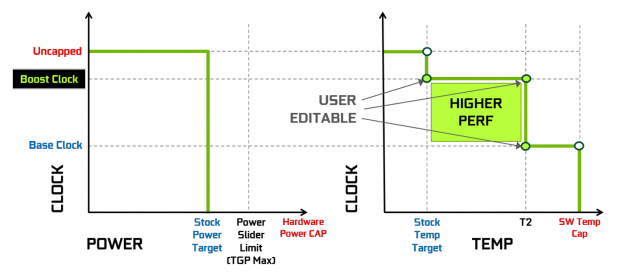
GPU Boost 4.0 takes overclocking to the next level by giving users access to the algorithms for GPU Boost itself, instead of them sitting inside of the driver with GPU Boost 3.0. NVIDIA says the biggest benefit with temperature on GPU Boost 4.0 is that where inflection points have been added.
Previously, the temperature was a straight line that dropped down next to Base Clock, but now it will holy the Boost Clock where you've overclocked it under higher temperatures before a second temp target (now T2) is hit, after which the GPU clocks will drop.
So. Awesome.
This means you can have additional performance from overclocking, and then if you spin the fans up on your GeForce RTX 20 series graphics card or have great airflow in your case, as long as you can keep the temperatures down. This should open up some doors for serious overclockers, with OC records surely reaching new heights with GeForce RTX 2080 Ti and GPU Boost 4.0 technology.
NVIDIA Scanner = Auto OC!
Automatic overclocking... it's here, right now with the new GeForce RTX series graphics cards. NVIDIA will have this technology inside of multiple AIB partners' software, with the company using EVGA's PrecisionX1 (which we had in early form for our review) and it works beautifully.
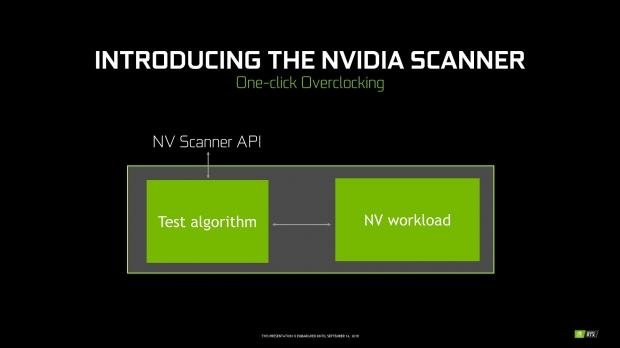
EVGA did a full re-design of their GPU management tool with PrecisionX1, where all of the inflection points in the Temp Tuner are editable, giving users full control of GPU Boost. We can expect new software to really push overclocking to the next level thanks to GPU Boost 4.0 and NVIDIA Scanner, where it will make it easier than ever for new users to overclock their graphics cards.
Overclocking your new RTX 20 series graphics card can take between 10-20 minutes to run, where it will launch a separate thread to test overclocking on the GPU. It will run a mathematical algorithm that tries to find single- and multi-bit failures so it can provide 100% stability at OC speeds. You can start the NVIDIA Scanner and stop it mid way through it you wanted to play a game, and then resume your overclocking adventures afterwards, too.
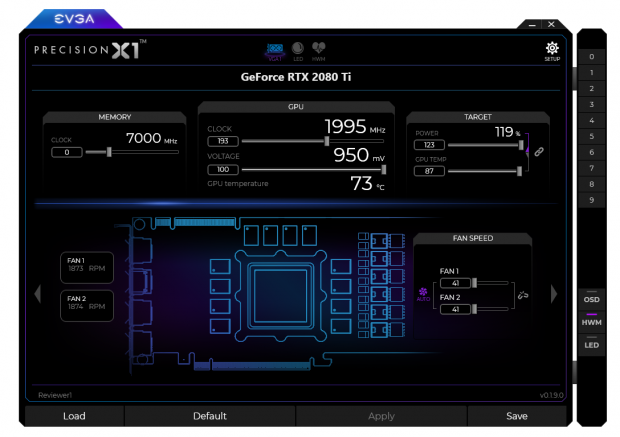
The power and temperature sliders have much more control over your maximum GPU clocks than ever before, so be sure to play around with them for maximum OC. I pushed my RTX 2080 Ti FE sample up to 2GHz at the 65-68C range with 100% fan speeds, +123 power and the GPU temps allowed to hit 88C. Not bad for the first few hours of playing with it.
Test System Specs
Our New GPU Test Rig
Welcome to the latest revision of our GPU test bed, with our system being upgraded from the Intel Core i7-7700K to the Core i7-8700K. The CPU is cooled by the Corsair H115i PRO cooler, with the 8700K overclocked to 5GHz. We've stayed with GIGABYTE for our motherboard with their awesome Z370 AORUS Gaming 7.
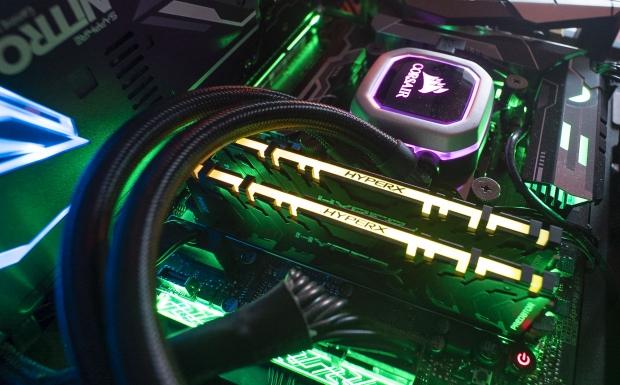
We approached our friends at HyperX for a kit of their kick ass HyperX Predator DDR4-2933MHz RAM (HX429C15PB3AK4/32), with 2 x 8GB sticks for a total of 16GB DDR4-2933. The RAM stands out through every minute of our testing as it has beautiful RGB lights giving the system a slick look while benchmarking our lives away, while the Z370 AORUS Gaming 7 motherboard joins in with its own array of RGB lighting.
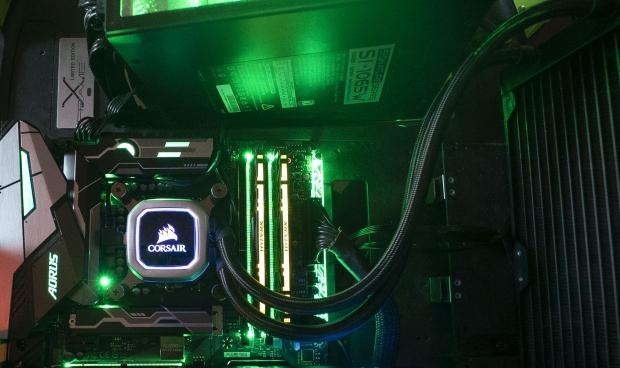
Detailed Tech Specs
- CPU: Intel Core i7-8700K @ 5GHz
- Cooler: Corsair Hydro Series H115i PRO
- MB: Z370 AORUS Gaming 7
- RAM: 16GB (2x8GB) HyperX Predator DDR4-2933
- SSD: 1TB OCZ RD400 NVMe M.2
- SSD: 512GB OCZ RD400 NVMe M.2
- PSU: InWin 1065W PSU
- Chassis: In Win X-Frame
- OS: Windows 10 Pro x64
Additional Images
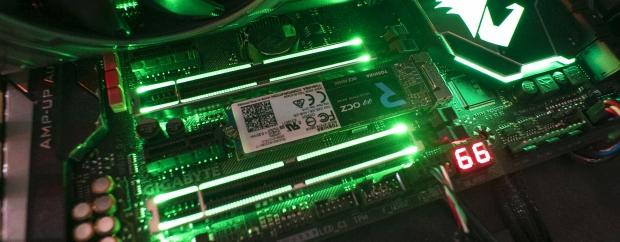
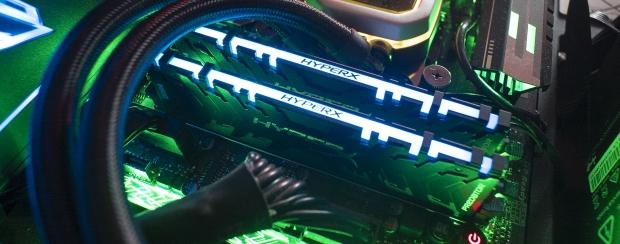
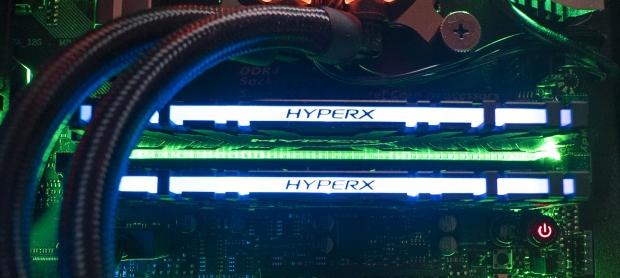
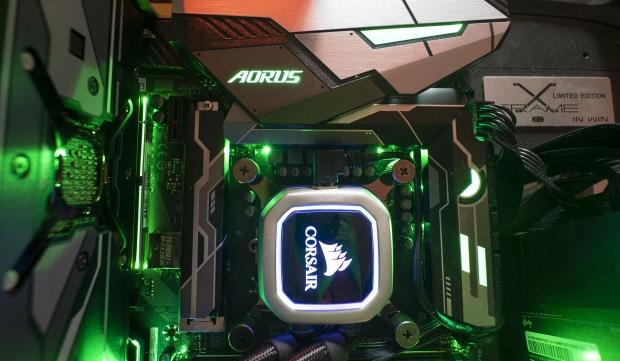
Benchmarks - Synthetic
3DMark Fire Strike - 1080p
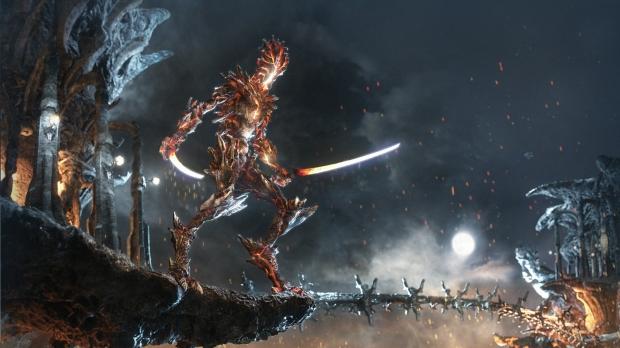
3DMark has been a staple benchmark for years now, all the way back to when The Matrix was released and Futuremark had bullet time inspired benchmarks. 3DMark is the perfect tool to see if your system - most important, your CPU and GPU - is performing as it should. You can search results for your GPU, to see if it falls in line with other systems based on similar hardware.
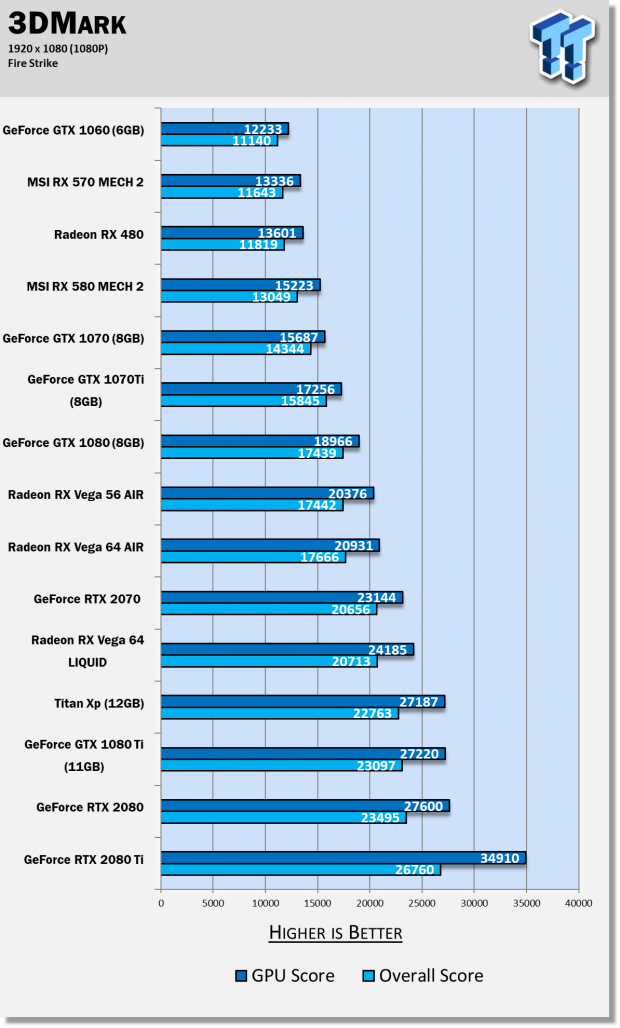
3DMark Fire Strike - 1440p
3DMark has been a staple benchmark for years now, all the way back to when The Matrix was released and Futuremark had bullet time inspired benchmarks. 3DMark is the perfect tool to see if your system - most important, your CPU and GPU - is performing as it should. You can search results for your GPU, to see if it falls in line with other systems based on similar hardware.
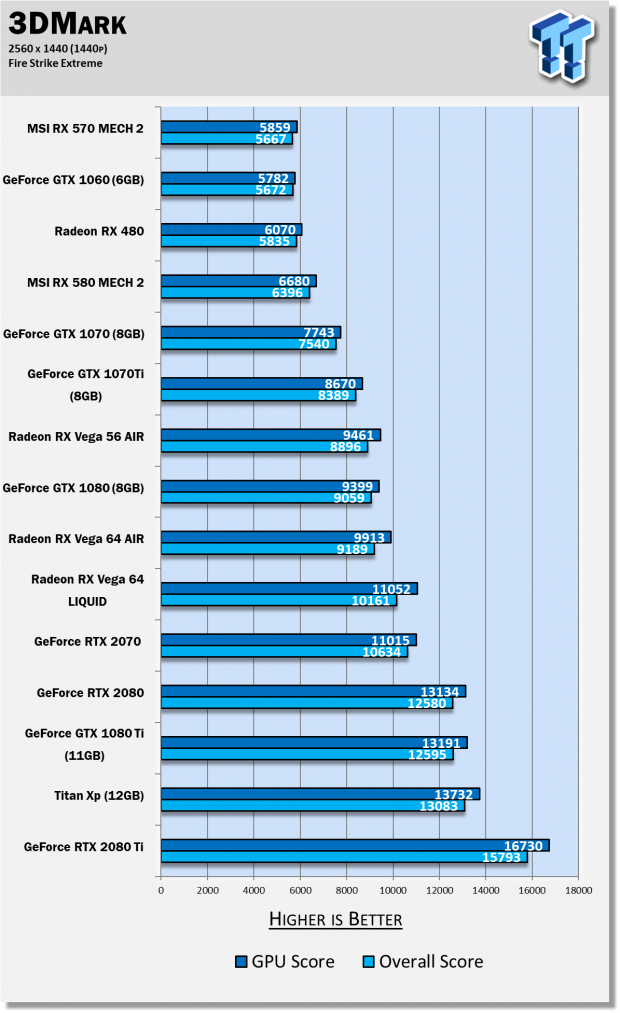
3DMark Fire Strike - 4K
3DMark has been a staple benchmark for years now, all the way back to when The Matrix was released and Futuremark had bullet time inspired benchmarks. 3DMark is the perfect tool to see if your system - most important, your CPU and GPU - is performing as it should. You can search results for your GPU, to see if it falls in line with other systems based on similar hardware.
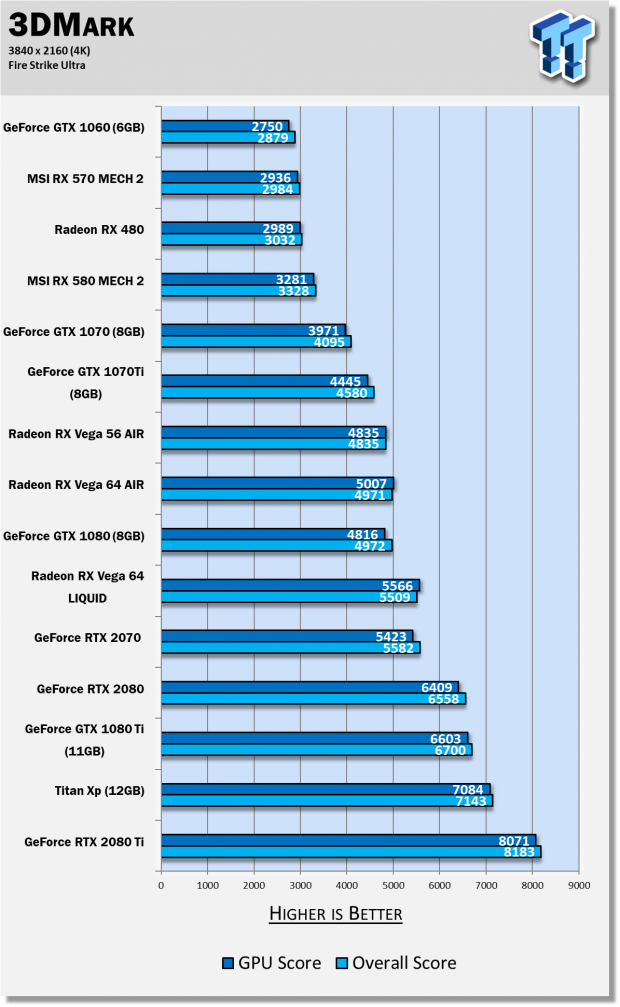
3DMark TimeSpy
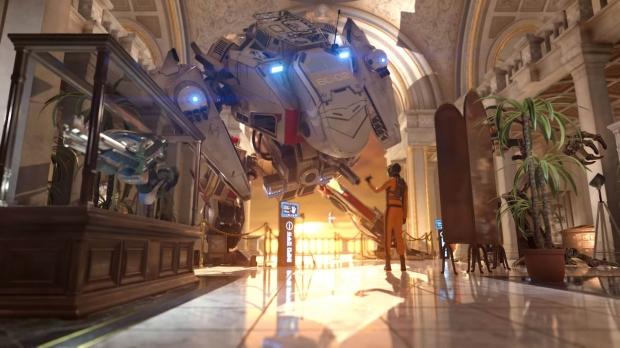
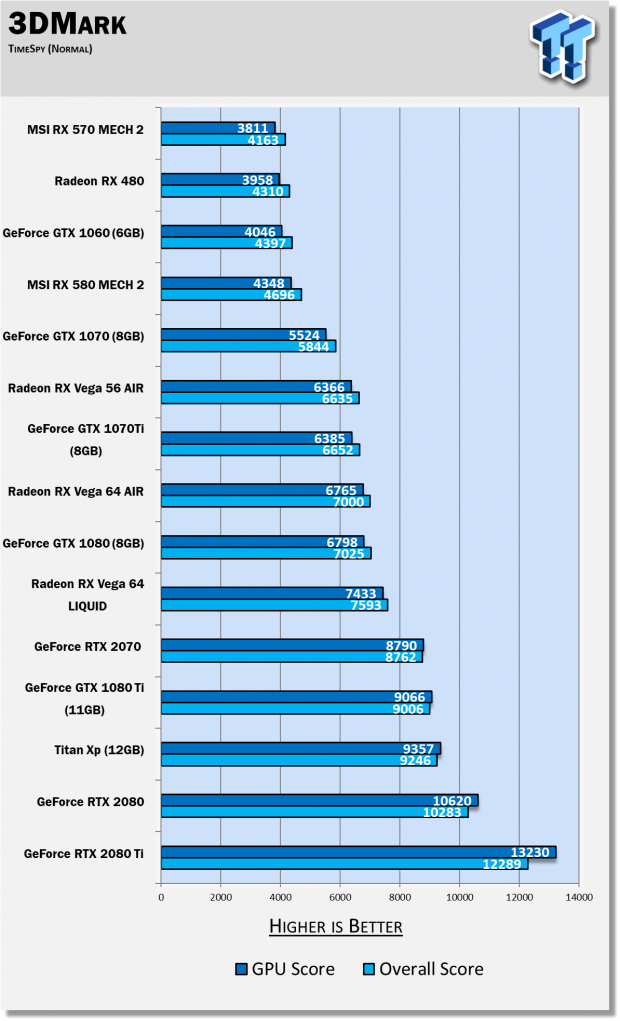
3DMark TimeSpy Extreme
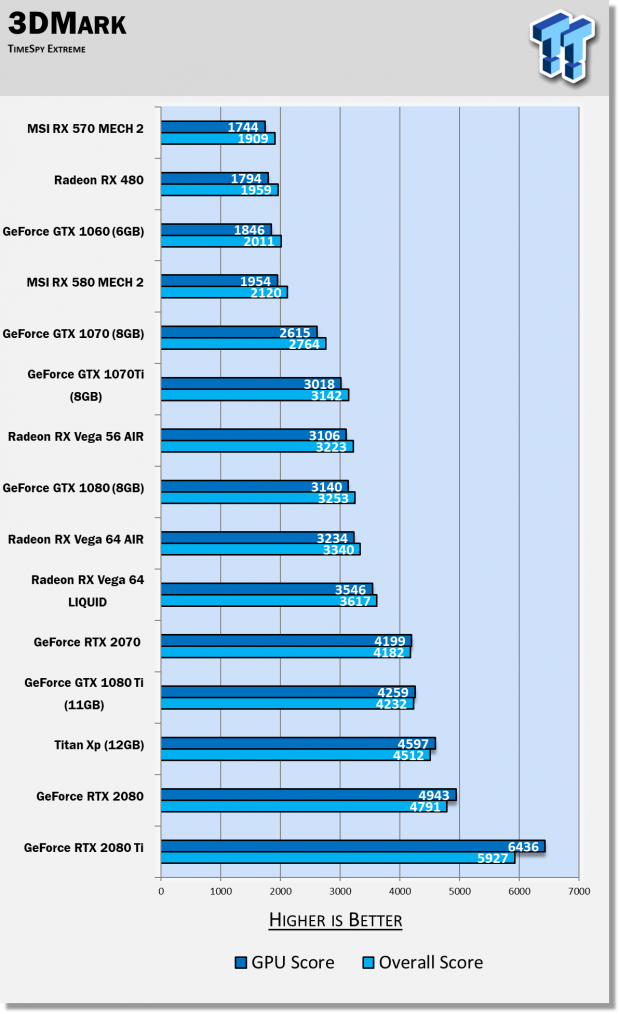
Heaven - 1080p
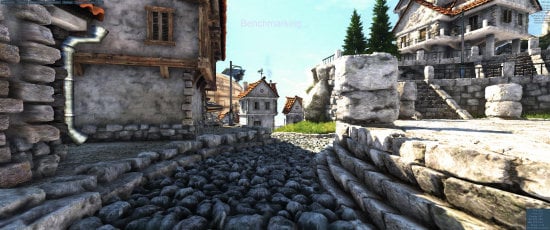
Heaven is an intensive GPU benchmark that really pushes your silicon to its limits. It's another favorite of ours as it has some great scaling for multi-GPU testing, and it's great for getting your GPU to 100% for power and noise testing.
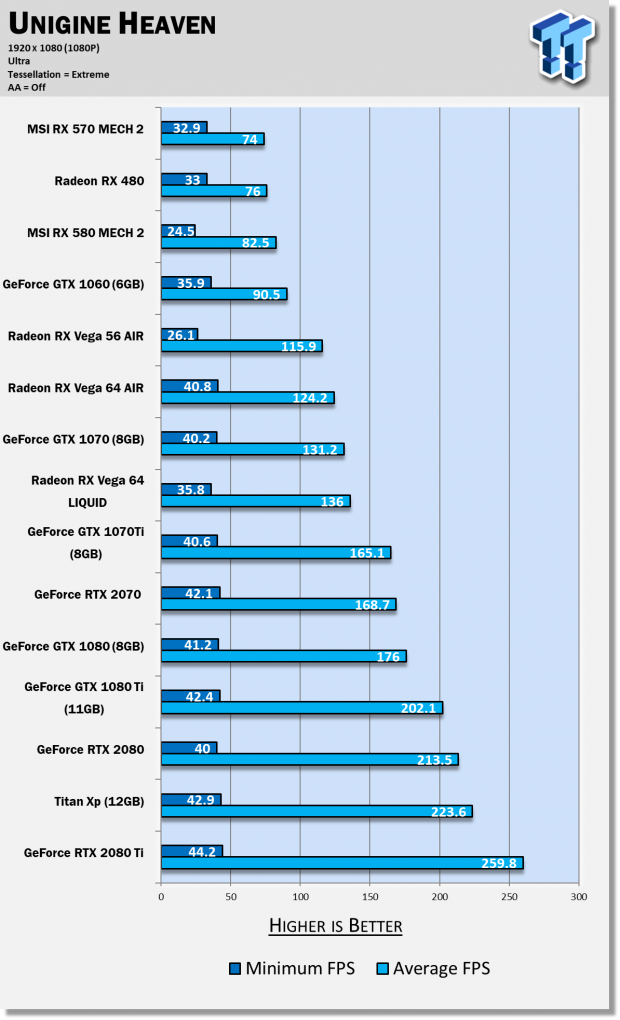
Heaven - 1440p
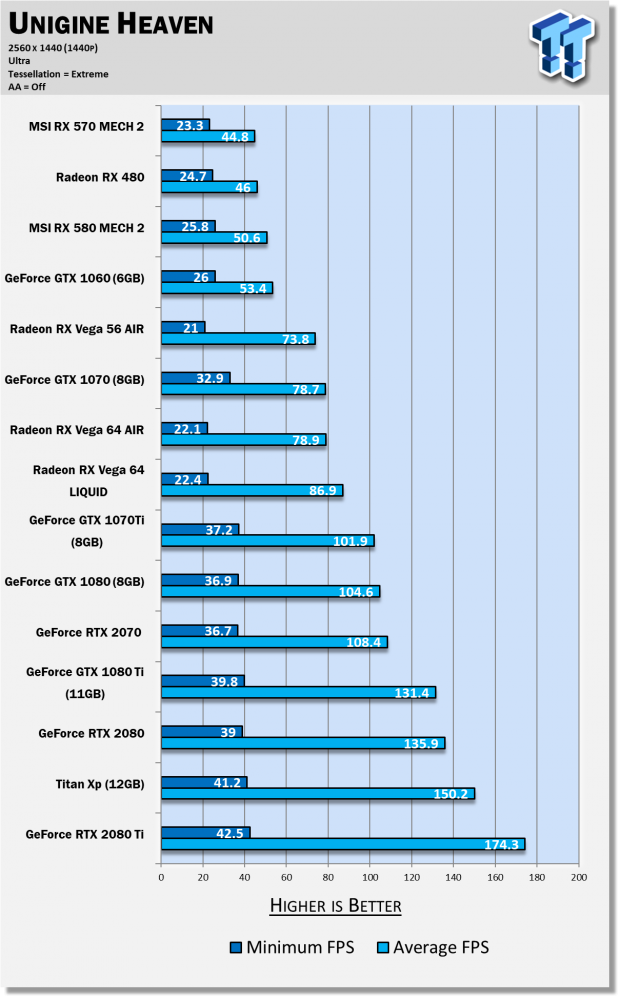
Heaven - 4K
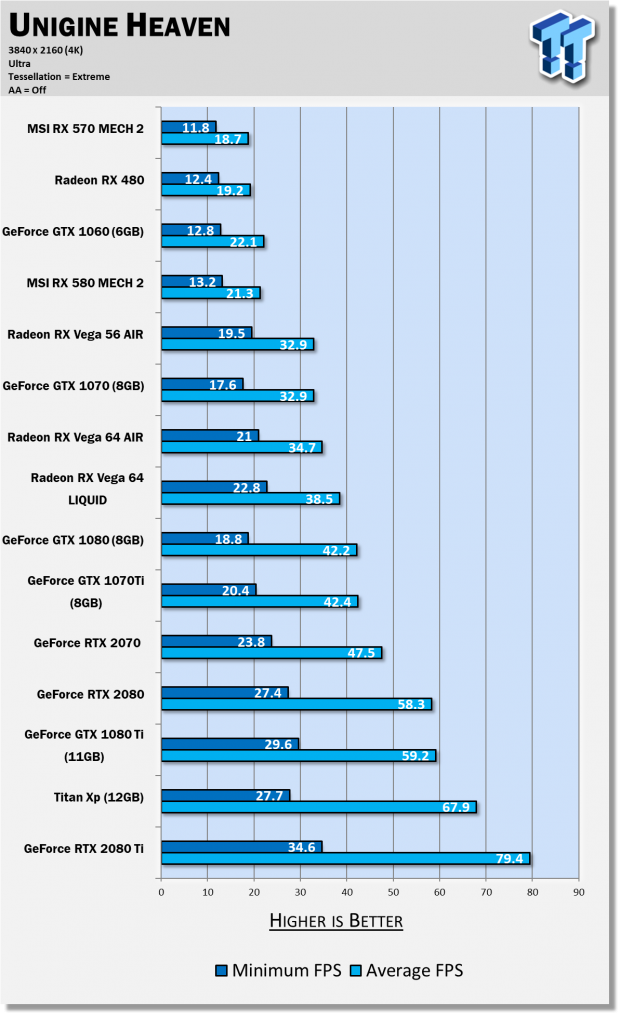
Benchmarks - 1080p
1080p Benchmarks

Rise of the Tomb Raider is one of the best looking games on the market, a truly gorgeous game - and a wonder to benchmark. The team at Crystal Dynamics made a very scalable PC game that plays really well testing graphics cards. We've got DX11 and DX12 results in one here, showing the slight strengths of running DX12 mode.
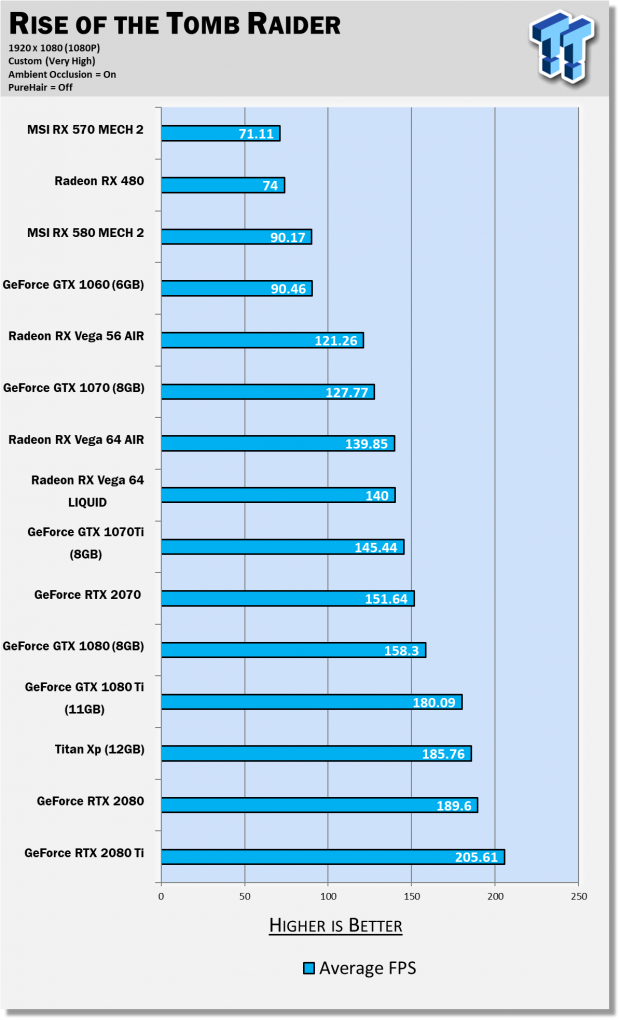
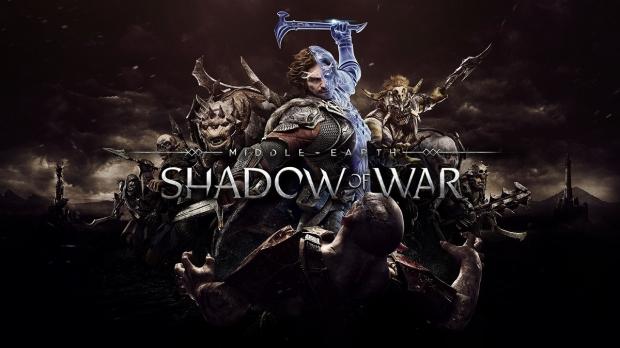
Middle-earth: Shadow of War is a sequel to the popular Shadow of Mordor, which was powered by the Lithtech engine. When cranked up to maximum detail, it will chew through your GPU and its VRAM like it's nothing.
You can buy Middle-earth: Shadow of War at Amazon.
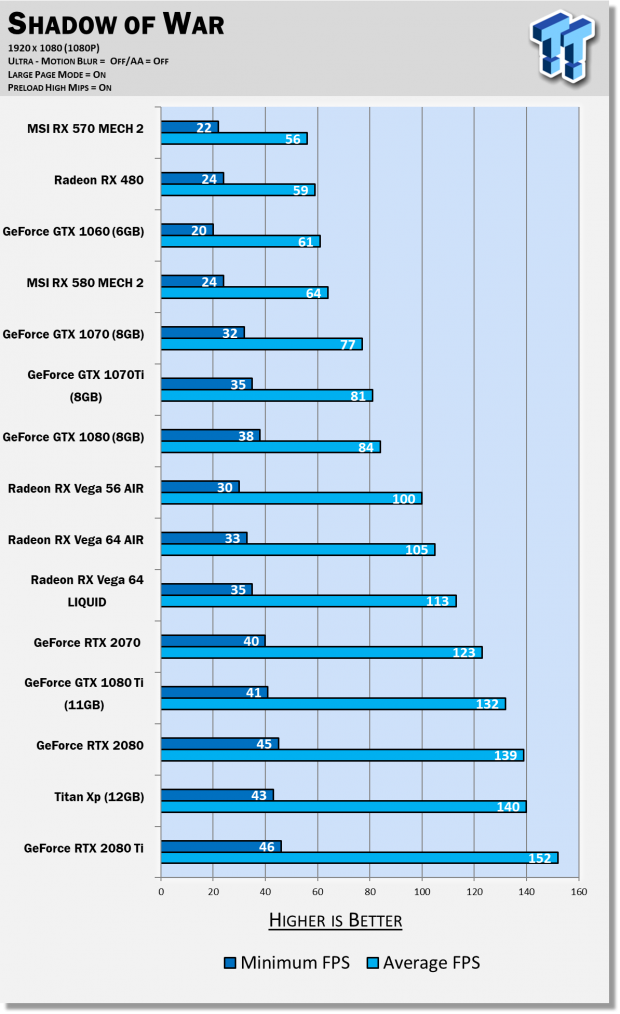
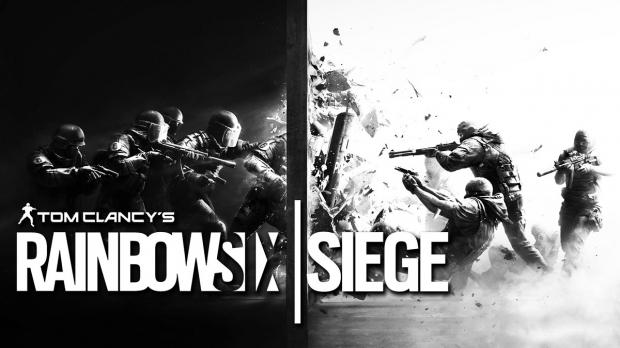
Rainbow Six: Siege has been a strong entry into the franchise, popular for its realistic feel and great graphics. Stable as a rock for benchmarking, right up to 3440x1440 and 4K.
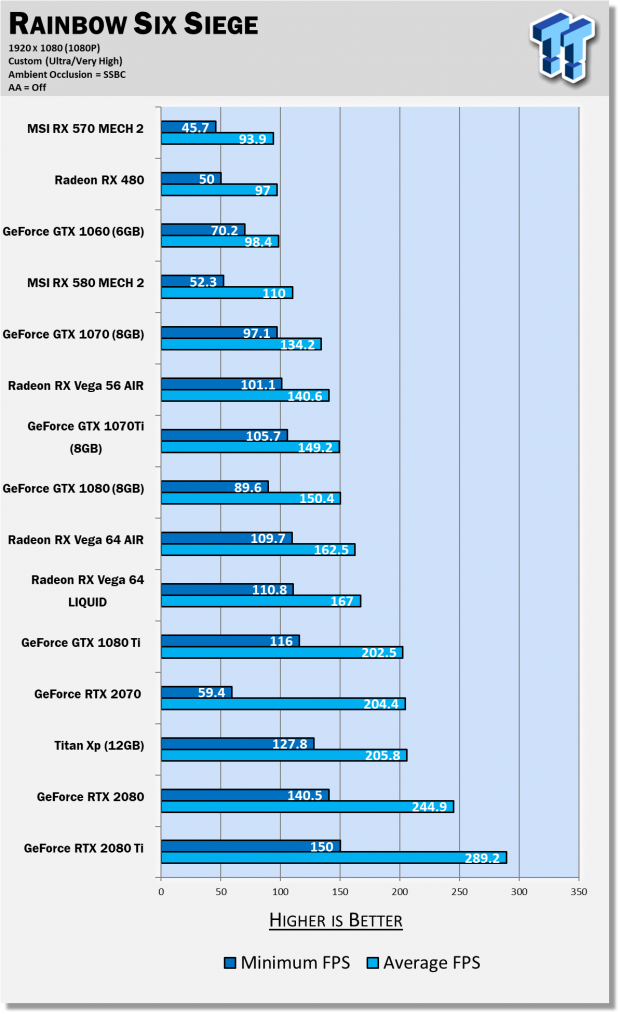
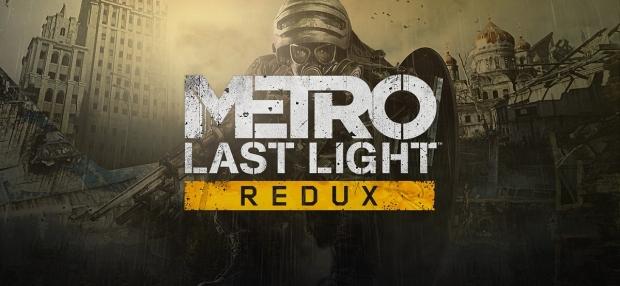
Metro: Last Light Redux comes from developer 4A Games, making the Redux version of Metro: Last Light the 'definitive' version of the game. Redux had a fresh coat of paint on the already impressive 4A Engine, and it really pushes our GPUs to their limits.
You can buy Metro: Last Light Redux at Amazon.
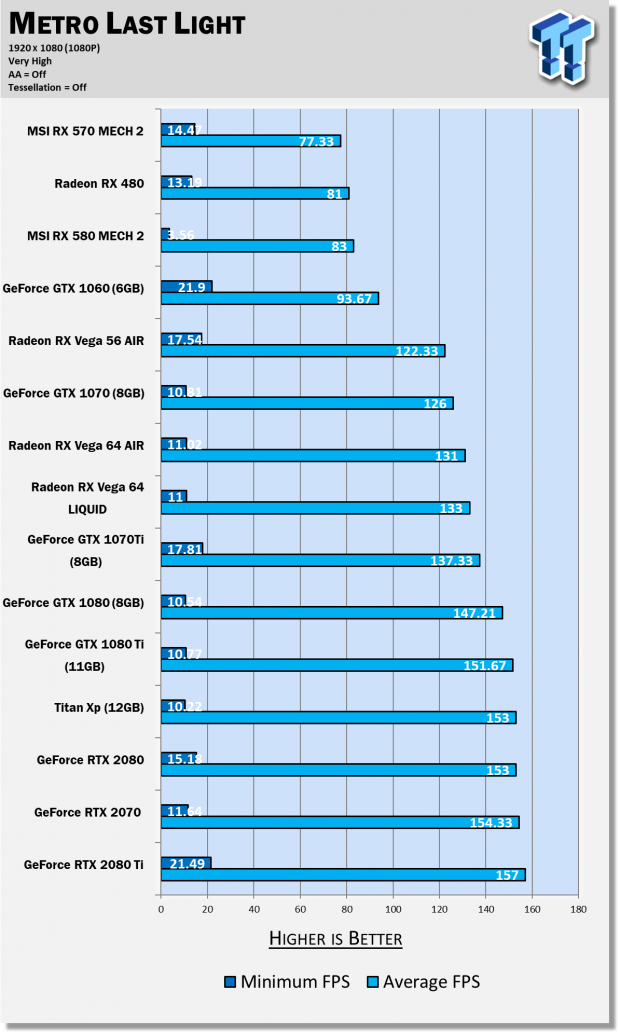

Far Cry 5 was developed by Ubisoft, and is powered the Dunia Engine, an engine that has been modified over the years for Far Cry. Dunia Engine itself was a modified version of CRYENGINE, scaling incredibly well on all sorts of hardware.


F1 2018 is the latest iteration of the super-popular franchise that Codemasters has worked on for close to a decade now, with F1 2009 kicking it all off. The game is powered by the EGO game engine, which is a modified version of the Neon game engine that was developed by Codemasters and Sony Computer Entertainment for Colin McRae: Dirt, which was released in 2007. The revamped EGO engine was developed to give Codemasters the ability of using more detailed damage and physics in the game world, as well as rendering larger-scale environments.
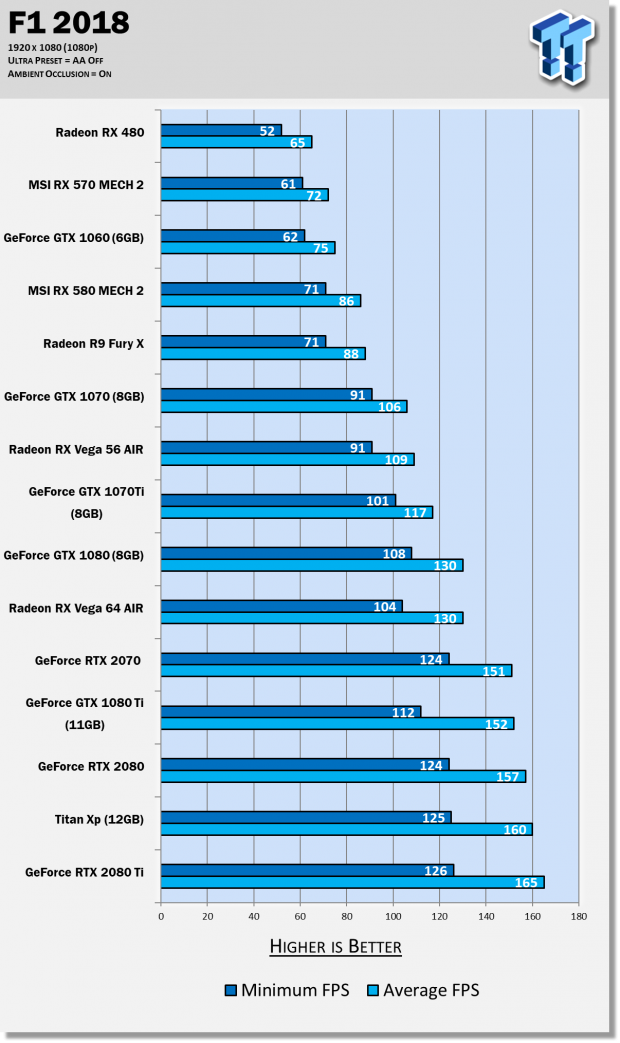

Shadow of the Tomb Raider is one of the latest games to join our graphics card benchmark lineup, with the game built using the Foundation engine as a base, the same engine in Rise of the Tomb Raider. Eidos Montreal R&D department made lots of changes to the engine during the development of Shadow of the Tomb Raider to make it one of the best-looking games out right now.
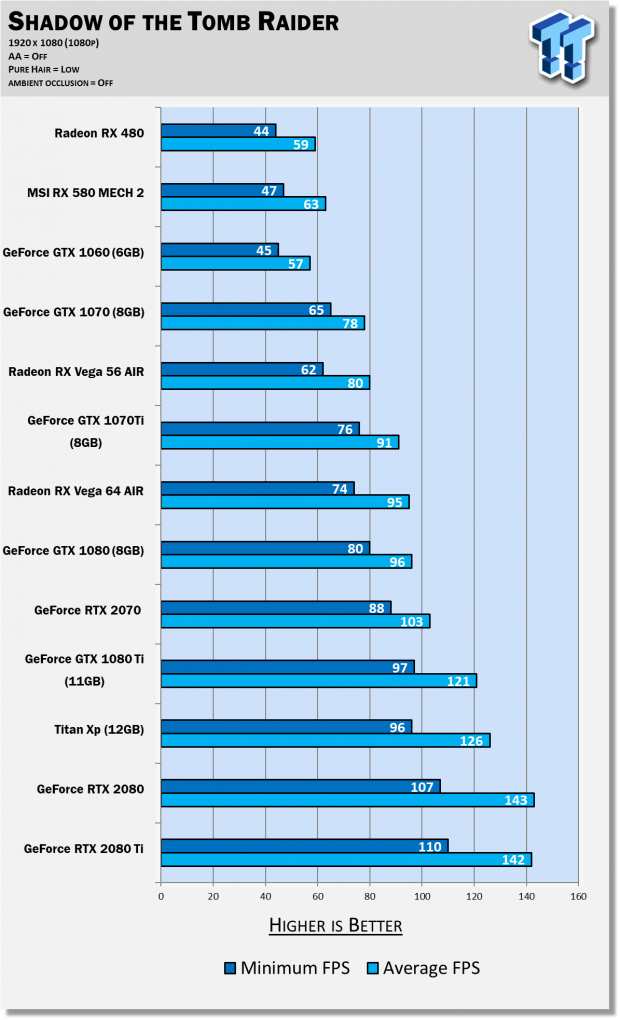
Benchmarks - 1440p
1440p Benchmarks

Rise of the Tomb Raider is one of the best looking games on the market, a truly gorgeous game - and a wonder to benchmark. The team at Crystal Dynamics made a very scalable PC game that plays really well testing graphics cards. We've got DX11 and DX12 results in one here, showing the slight strengths of running DX12 mode.
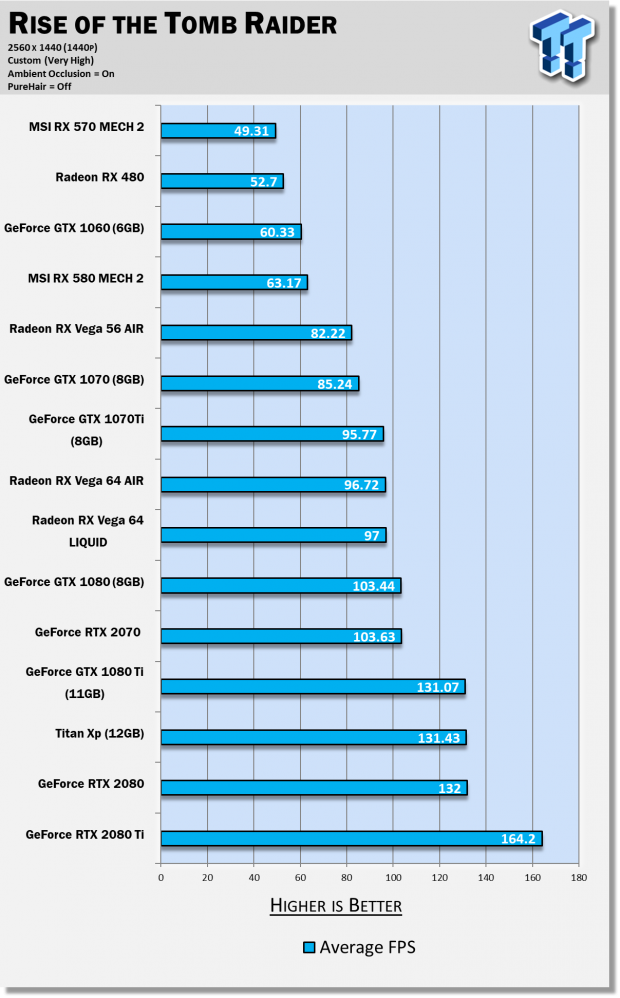

Middle-earth: Shadow of War is a sequel to the popular Shadow of Mordor, which was powered by the Lithtech engine. When cranked up to maximum detail, it will chew through your GPU and its VRAM like it's nothing.
You can buy Middle-earth: Shadow of War at Amazon.
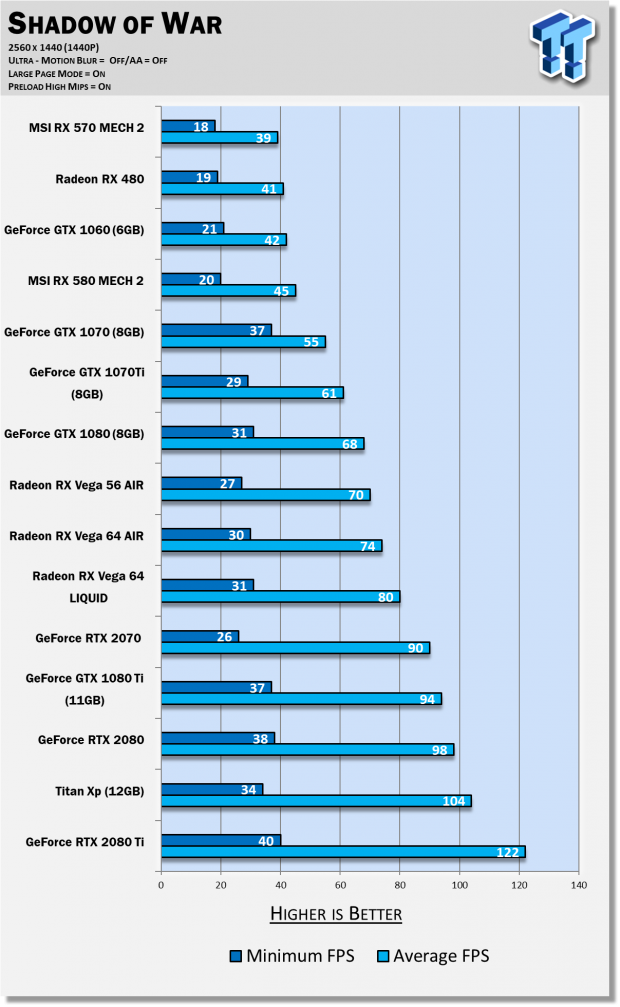

Rainbow Six: Siege has been a strong entry into the franchise, popular for its realistic feel and great graphics. Stable as a rock for benchmarking, right up to 3440x1440 and 4K.
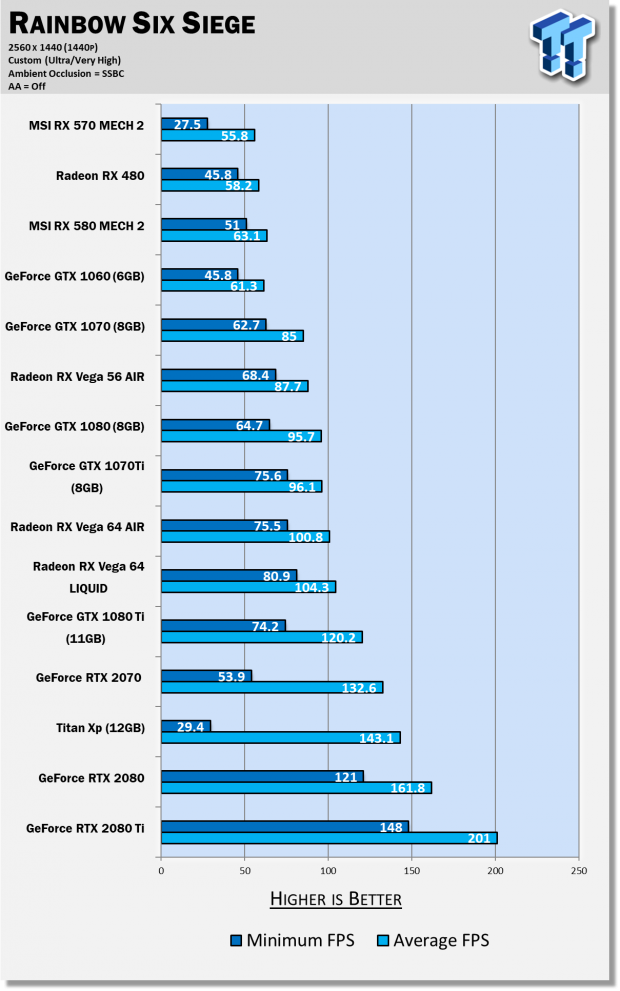

Metro: Last Light Redux comes from developer 4A Games, making the Redux version of Metro: Last Light the 'definitive' version of the game. Redux had a fresh coat of paint on the already impressive 4A Engine, and it really pushes our GPUs to their limits.
You can buy Metro: Last Light Redux at Amazon.
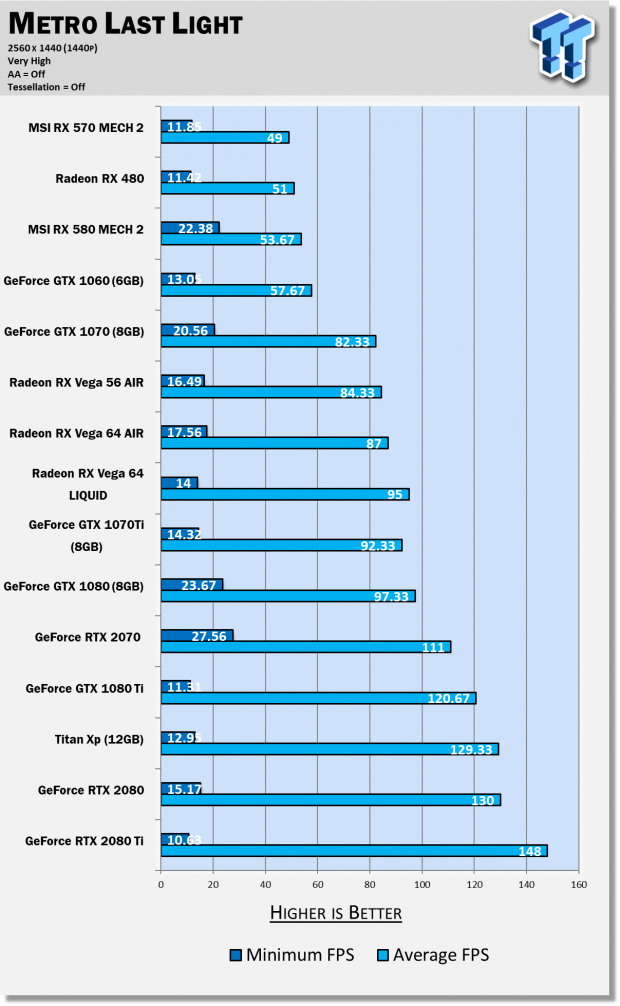

Far Cry 5 was developed by Ubisoft, and is powered the Dunia Engine, an engine that has been modified over the years for Far Cry. Dunia Engine itself was a modified version of CRYENGINE, scaling incredibly well on all sorts of hardware.
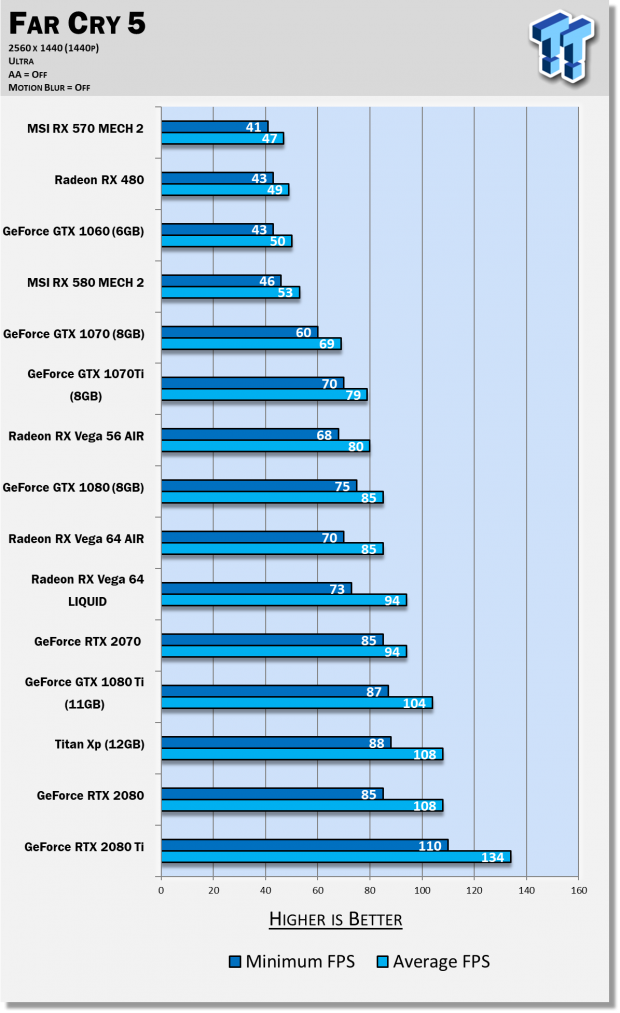

F1 2018 is the latest iteration of the super-popular franchise that Codemasters has worked on for close to a decade now, with F1 2009 kicking it all off. The game is powered by the EGO game engine, which is a modified version of the Neon game engine that was developed by Codemasters and Sony Computer Entertainment for Colin McRae: Dirt, which was released in 2007. The revamped EGO engine was developed to give Codemasters the ability of using more detailed damage and physics in the game world, as well as rendering larger-scale environments.
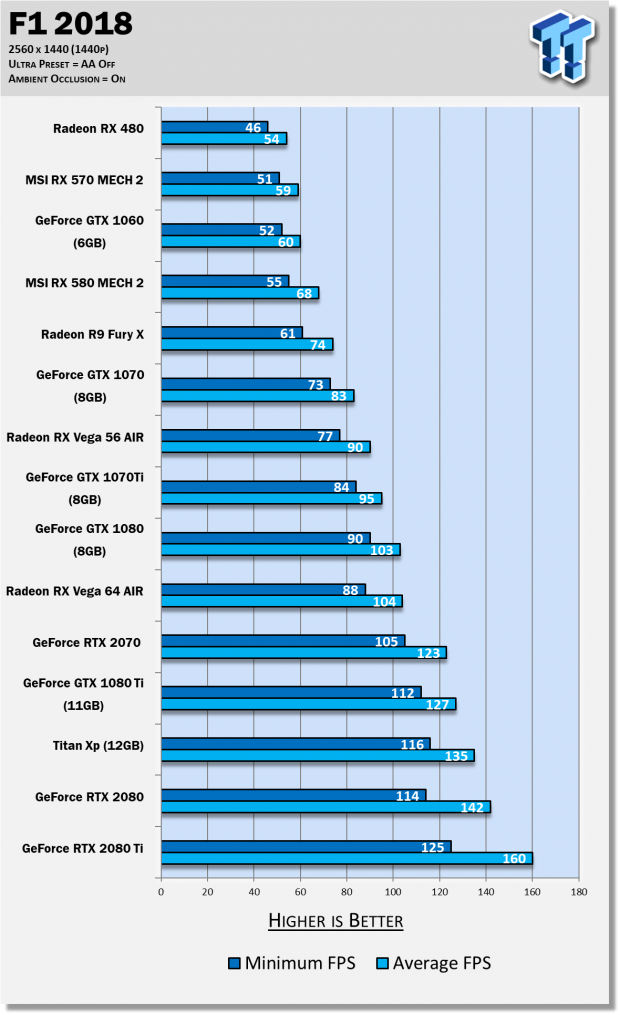

Shadow of the Tomb Raider is one of the latest games to join our graphics card benchmark lineup, with the game built using the Foundation engine as a base, the same engine in Rise of the Tomb Raider. Eidos Montreal R&D department made lots of changes to the engine during the development of Shadow of the Tomb Raider to make it one of the best-looking games out right now.
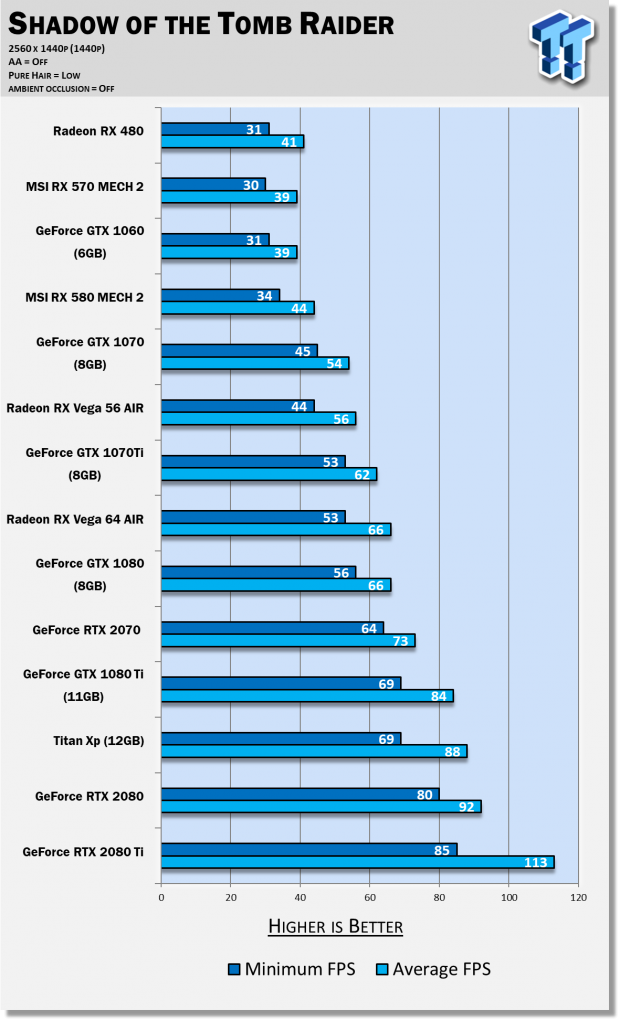
Benchmarks - 3440x1440
3440 x 1440 Benchmarks
We didn't have enough time for 3440x1440 benchmarks, so this page will be updated in the next 24 hours with those results.
Benchmarks - 4K
4K Benchmarks

Rise of the Tomb Raider is one of the best looking games on the market, a truly gorgeous game - and a wonder to benchmark. The team at Crystal Dynamics made a very scalable PC game that plays really well testing graphics cards. We've got DX11 and DX12 results in one here, showing the slight strengths of running DX12 mode.
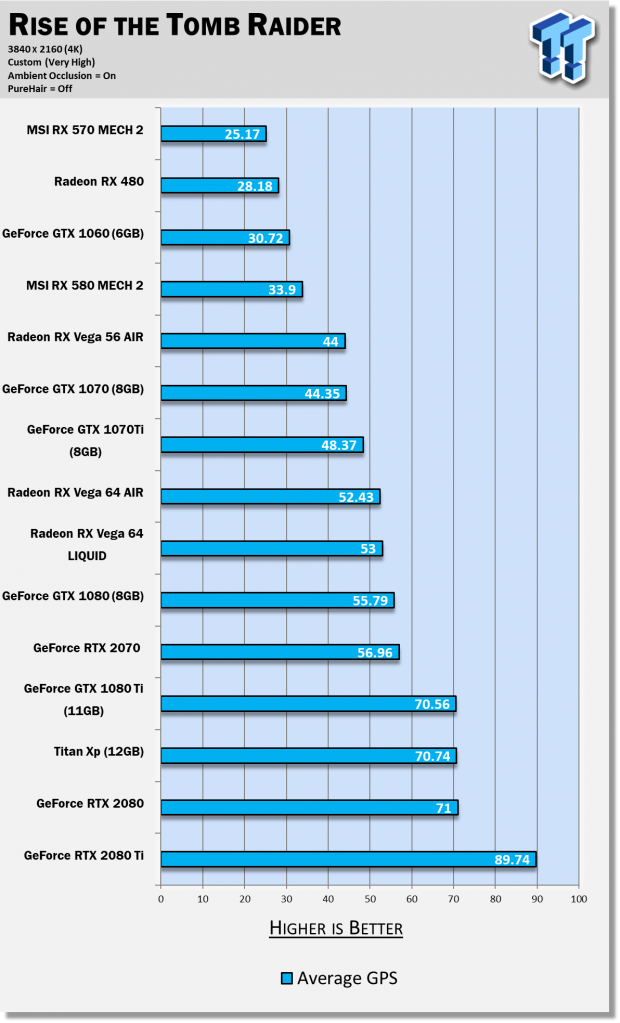

Middle-earth: Shadow of War is a sequel to the popular Shadow of Mordor, which was powered by the Lithtech engine. When cranked up to maximum detail, it will chew through your GPU and its VRAM like it's nothing.
You can buy Middle-earth: Shadow of War at Amazon.
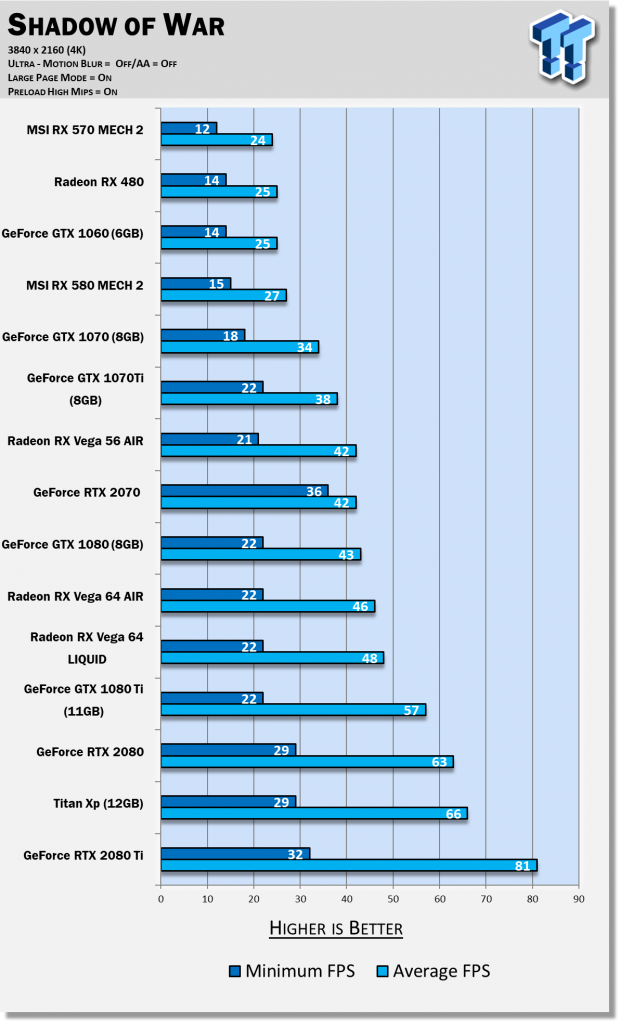

Rainbow Six: Siege has been a strong entry into the franchise, popular for its realistic feel and great graphics. Stable as a rock for benchmarking, right up to 3440x1440 and 4K.
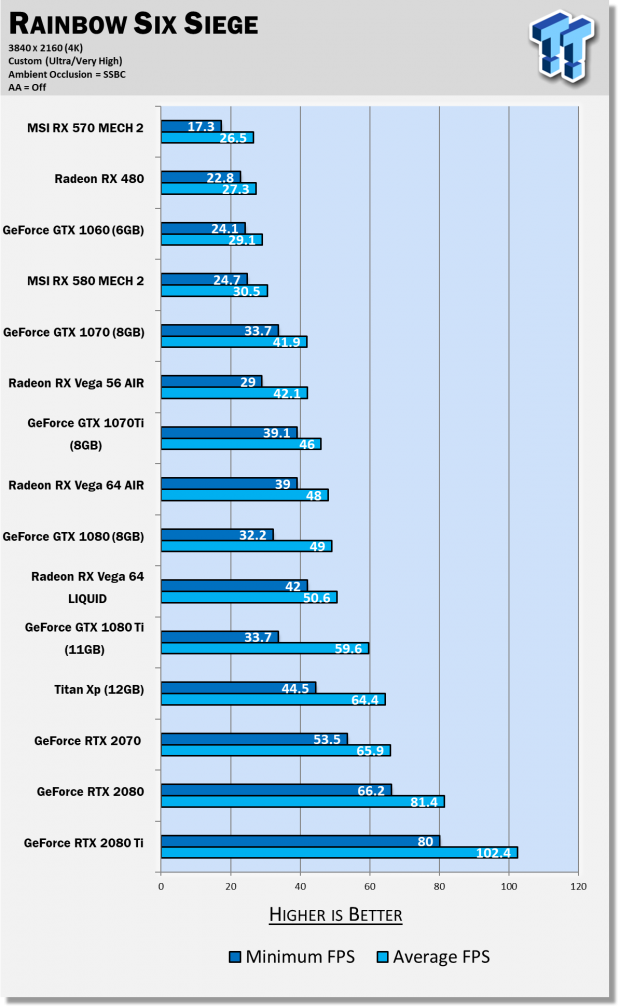

Metro: Last Light Redux comes from developer 4A Games, making the Redux version of Metro: Last Light the 'definitive' version of the game. Redux had a fresh coat of paint on the already impressive 4A Engine, and it really pushes our GPUs to their limits.
You can buy Metro: Last Light Redux at Amazon.
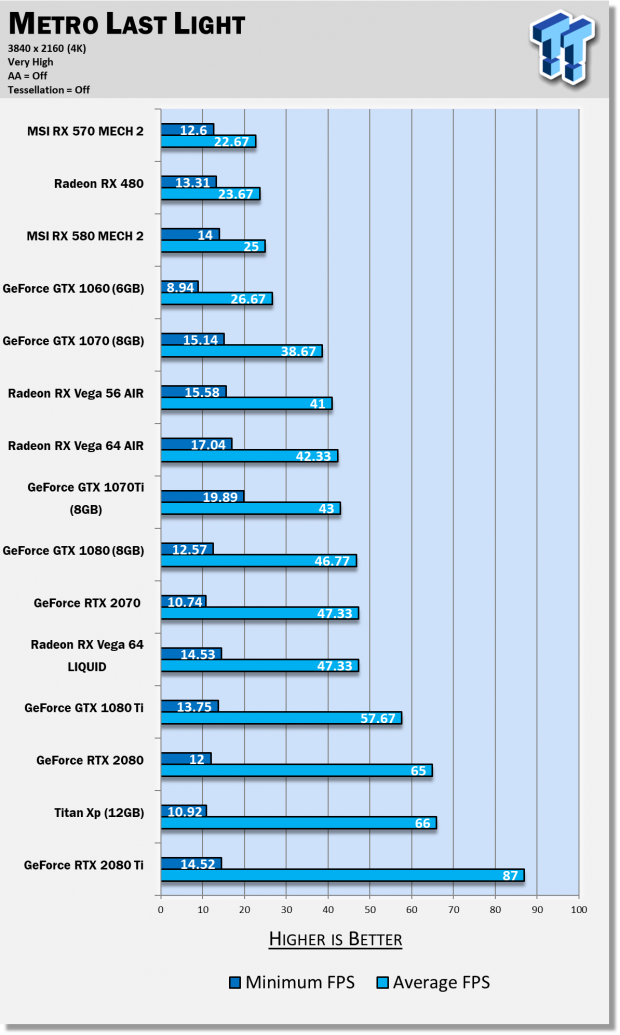

Far Cry 5 was developed by Ubisoft, and is powered the Dunia Engine, an engine that has been modified over the years for Far Cry. Dunia Engine itself was a modified version of CRYENGINE, scaling incredibly well on all sorts of hardware.
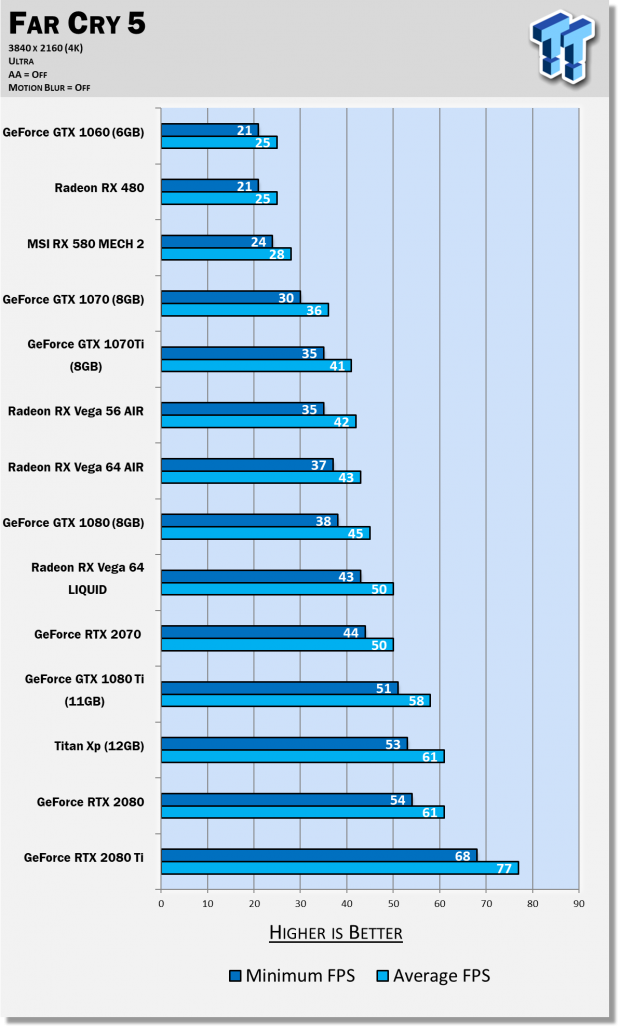

F1 2018 is the latest iteration of the super-popular franchise that Codemasters has worked on for close to a decade now, with F1 2009 kicking it all off. The game is powered by the EGO game engine, which is a modified version of the Neon game engine that was developed by Codemasters and Sony Computer Entertainment for Colin McRae: Dirt, which was released in 2007. The revamped EGO engine was developed to give Codemasters the ability of using more detailed damage and physics in the game world, as well as rendering larger-scale environments.
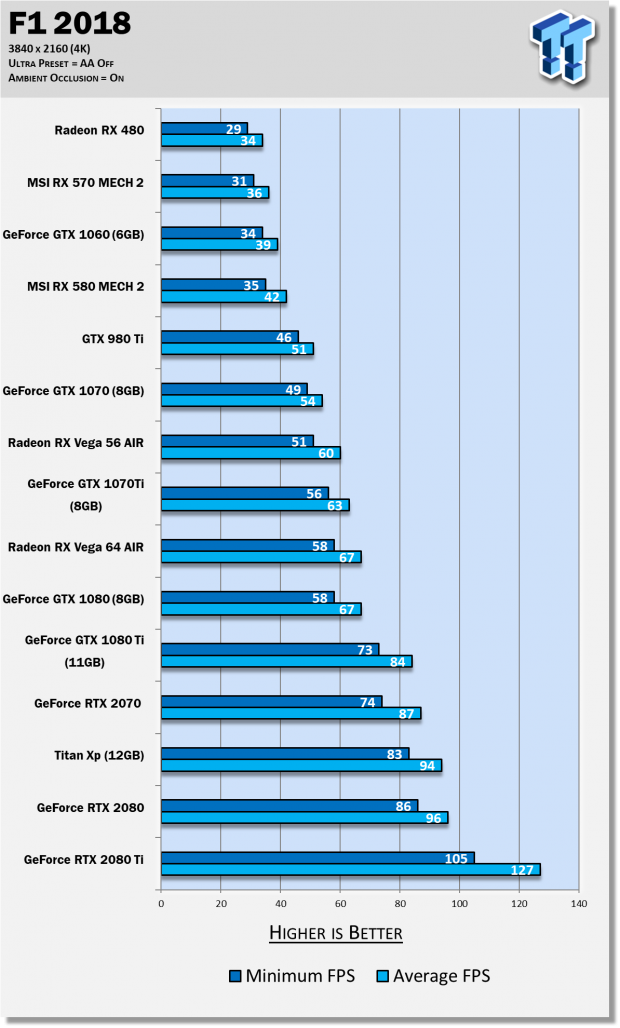

Shadow of the Tomb Raider is one of the latest games to join our graphics card benchmark lineup, with the game built using the Foundation engine as a base, the same engine in Rise of the Tomb Raider. Eidos Montreal R&D department made lots of changes to the engine during the development of Shadow of the Tomb Raider to make it one of the best-looking games out right now.
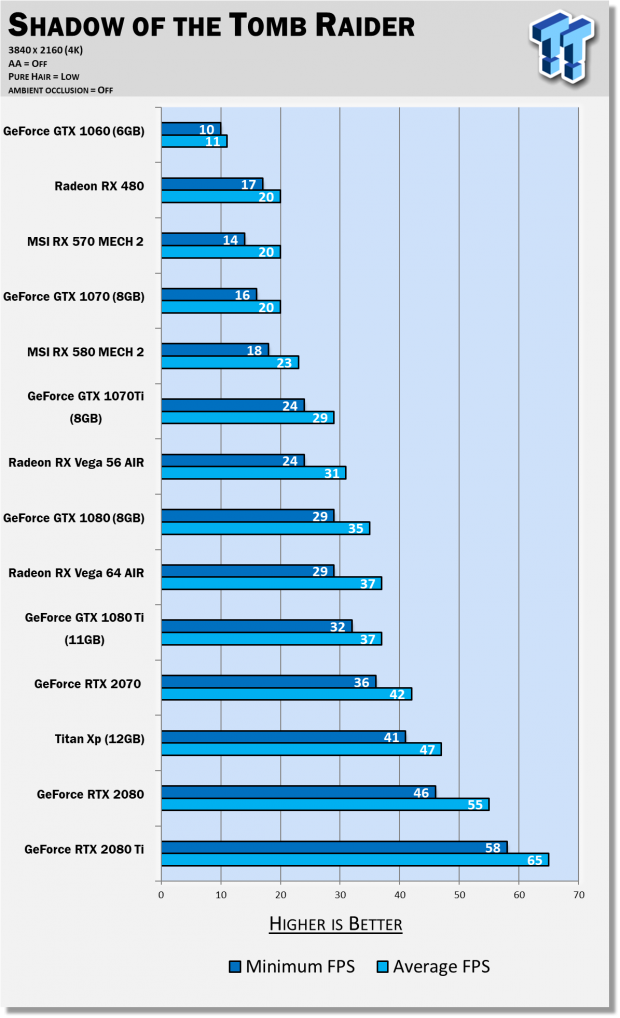
Benchmarks - 8K
8K Benchmarks
We didn't have enough time for 8K benchmarks, so this page will be updated in the next 24 hours with those results.
Overclocking
Overclocking Turing & GDDR6
This is something else I haven't had the time to test just yet, but there will be more details on this in the coming days!
Heat, Power, Noise
71C Max For GeForce RTX 2070
NVIDIA's own GeForce RTX 2070 Founders Edition runs at 71C max under 60 minutes of solid 100% testing with the fans settling at 50% which saw the fans spinning at 1830RPM or so. The card isn't that loud, with the RTX 2070 Founders Edition offering quiet gaming that packs a big performance punch.
Power Consumption
I've got to make a chart yet but it's running late, so whoever gets to this page and not straight to the benchmarks... this is a WORK IN PROGRESS part of the review. But, running Heaven at 4K on the GeForce RTX 2070 Founders Edition sees the total system power consumption hitting 260W.
Performance Between GTX 1080 and GTX 1080 Ti
The Perfect Card For 1440p
If there was a single resolution where the new GeForce RTX 2070 stands out it would be 2560x1440, where it ensures at least 60FPS in all of the games we tested. We're looking at a 30% or higher average improvement over the GeForce GTX 1070, with performance finding itself more between the GTX 1080 and higher-end GTX 1080 Ti.

NVIDIA debuted the Pascal GPU architecture with the GeForce GTX 1080 and GTX 1070 in May 2016, and since then there have been cards between these two (GTX 1070 Ti) just past the GTX 1080 (GTX 1080 models with 11Gbps GDDR5X) and above it: GTX 1080 Ti and TITAN Xp. The new GeForce RTX 2080 sits between the GTX 1080 Ti and the TITAN Xp, while the RTX 2080 Ti blows past them both.
The new GeForce RTX 2070 that we have here today comfortably beats the GTX 1070 and even the GTX 1080, while trading blows with the GeForce GTX 1080 Ti in some games, especially where memory bandwidth comes into play. Hell, the new RTX 2070 in some games even keeps up with the TITAN Xp, a $1200 graphics card. You wouldn't buy the RTX 2070 for these specific situations, but if you wanted to buy something new and not a GPU that is now over two years old, the RTX 2070 offers solid 1440p performance.
Assassin's Creed Odyssey is the very latest benchmark added to our suite (Call of Duty: Black Ops 4 is coming after this article, with 8K results in tow) and boy does it run well on the GeForce RTX 2080.
Against GTX 1080/GTX 1080 Ti: At 2560x1440 we were seeing 59FPS average while the GTX 1080 it pushing just 50FPS average, while the GTX 1080 Ti beats the RTX 2070 by 2FPS with 61FPS average. The RTX 2080 is only just ahead with 63FPS while the RTX 2080 Ti takes a larger leap to 73FPS average.
Against GTX 1070: We're looking at 17FPS minimum and 41FPS average on the GeForce GTX 1070, compared to the 26FPS minimum and 59FPS average, a performance increase of 44%.
Shadow of the Tomb Raider is one of the newest games on our benchmarking roster, and it runs at 64FPS minimum and 73FPS average at 1440p.
Against GTX 1080/GTX 1080 Ti: If we compare this to the 66FPS average on the GTX 1080, and 84FPS of the GTX 1080 Ti, we can see the RTX 2070 falling right into the middle of the two higher-end Pascal cards in Lara's latest adventures. The previous-gen $1199 graphics card in the TITAN Xp is pushing out 88FPS average at 1440p, while the Radeon RX Vega 64 loses to the RTX 2070 with 66FPS average.
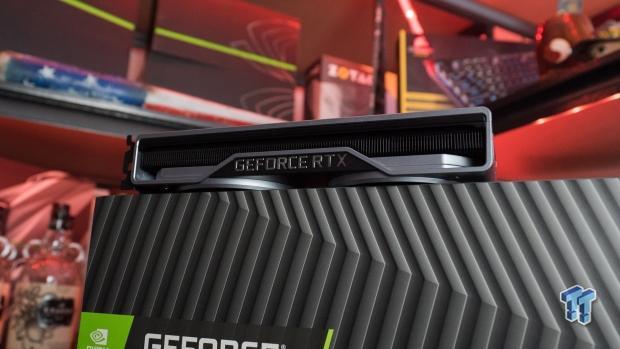
Against GTX 1070: The GTX 1070 is capable of 45FPS minimum and 54FPS average in Shadow of the Tomb Raider at 1440p, while the new RTX 2070 and its 64FPS minimum and 73FPS average. This is a jump of 35% average FPS.
Far Cry 5 is still one of the best looking games on the market, with Ubisoft doing a great job on PC graphics card scaling and multi-GPU at higher resolutions.
Against GTX 1080/GTX 1080 Ti: Even gorgeous games like Far Cry 5 run like butter on the RTX 2070 with 94FPS average at 1440p, against 85FPS average on the GTX 1080 and 104FPS on the GTX 1080 Ti. TITAN Xp is achieving 108FPS average at 1440p, beating out all of the cards but that's expected for $1199.
Against GTX 1070: The Pascal-based GeForce GTX 1070 hits 69FPS average at 1440p compared to 79FPS average, a smaller but still significant 15% increase in performance.
Final Thoughts... More To Come
Final Thoughts
Price is something I don't want to talk about for a couple of weeks, until these cards are in gamers' hands and not at the "starts from $499" price that NVIDIA has slapped onto the GeForce RTX 2070. I'm only looking at the full picture of performance for now, and at 2560x1440 more specifically.
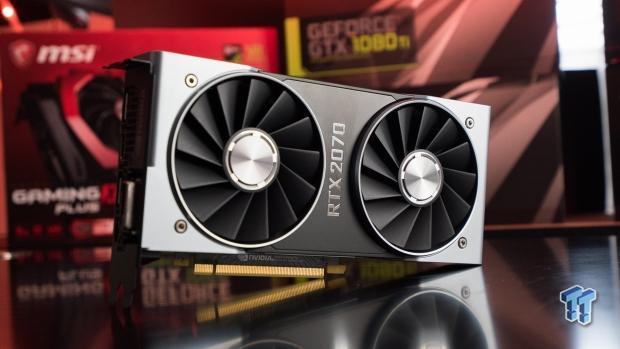
Personally, I think the performance on show from NVIDIA with the GeForce RTX 2070 is pretty damn good considering it can battle the GTX 1080 which sits on Amazon for $500+ right now. The GeForce RTX 2070 starts from $499 but I don't want to put any final thoughts into a card and its price point until it stabilizes. If we're comparing it in the $499-$599 range, then it is offering better-than-GTX 1080 performance for either a little cheaper, or the same price.
You'd be silly to buy the GeForce GTX 1080 brand new these days as you can get the newer GTX 1070 Ti or a second hand GTX 1080 Ti for a little more. If you're buying new, then the RTX 2070 is great new contender for the $500 to $600 price bracket.
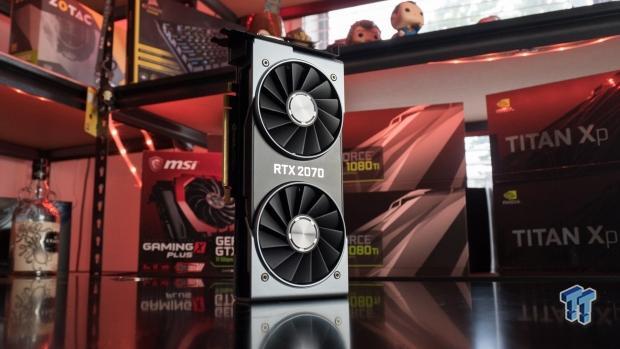
NVIDIA's new GeForce RTX 2070 leaves AMD's flagship Radeon RX Vega 64 graphics card behind in performance, and is close to the same price with the RX Vega 64 sitting between $500-$650. Vega 64 is way hotter, way louder, a year old, and I wouldn't recommend buying it over the GTX 1070 Ti let alone the new RTX 2070. This is just in performance, a clear 'buy it now' from me but when it comes to power/noise/etc I recommend the RTX 2070 over any Radeon card any day of the week.
For now, the RTX 2070 offers some stellar performance at 2560x1440 but we're going to see how it runs at 3440x1440 and 7680x4320 next. There's a lot of fun stuff coming up involving the RTX 2070, but for now what do you think? Better than you thought? Worse than you thought?

| Performance (overclocking, power) | 90% |
| Quality (build, design, cooling) | 95% |
| General Features (display outputs, etc) | 100% |
| Bundle, Packaging & Software | 100% |
| Overall | 96% |
The Bottom Line: NVIDIA's new GeForce RTX 2070 offers performance somewhere between the GeForce GTX 1080 and GTX 1080 Ti, all in a single 8-pin PCIe power connector. There's plenty of fun to be had for a card starting at $499, blowing everything AMD has away with the third-fastest Turing card from NVIDIA.
PRICING: You can find products similar to this one for sale below.
 United
States: Find other tech and computer products like this
over at Amazon.com
United
States: Find other tech and computer products like this
over at Amazon.com
 United
Kingdom: Find other tech and computer products like this
over at Amazon.co.uk
United
Kingdom: Find other tech and computer products like this
over at Amazon.co.uk
 Australia:
Find other tech and computer products like this over at Amazon.com.au
Australia:
Find other tech and computer products like this over at Amazon.com.au
 Canada:
Find other tech and computer products like this over at Amazon.ca
Canada:
Find other tech and computer products like this over at Amazon.ca
 Deutschland:
Finde andere Technik- und Computerprodukte wie dieses auf Amazon.de
Deutschland:
Finde andere Technik- und Computerprodukte wie dieses auf Amazon.de
What's in Anthony's PC?
- CPU: Intel Core i5-12600K
- MOTHERBOARD: GIGABYTE Z690 AERO-G
- RAM: Corsair 32GB DDR4-3200
- GPU: NVIDIA GeForce RTX 4090 24GB
- SSD: Sabrent 4TB Rocket 4 Plus
- OS: Windows 11 Pro
- CASE: Lian Li O11 Dynamic XL
- PSU: ASUS ROG Strix 850W
- KEYBOARD: Logitech G915 Wireless
- MOUSE: Logitech G502X Wireless
- MONITOR: LG C3 48-inch OLED TV 4K 120Hz
Similar Content
Related Tags

